Recent Trends in Advanced Radiation Shielding Concrete for Construction of Facilities: Materials and Properties
Abstract
:1. Introduction
2. Classifications and Major Functions of RSC
3. Alternative Materials Used in RSC
3.1. Binder
3.2. Aggregate
3.2.1. Natural Aggregate/Low-Density Aggregate
3.2.2. Natural Heavyweight Aggregate
3.2.3. Natural Aggregate with Crystallized Water
3.2.4. Synthetic Aggregate
3.2.5. Mine Wastes
3.2.6. Industrial Waste
3.3. Beneficial Additive
4. Radiation Shielding
4.1. Gamma Ray Shielding
4.1.1. Test Setup for Gamma Ray Shielding
4.1.2. Performance of RSC on Gamma Ray Shielding
4.2. Neutron Shielding
4.2.1. Test Setup for Neutron Shielding
4.2.2. Performance of RSC on Neutron Shielding
5. Mechanical Strength Properties
5.1. Compressive Strength
5.2. Splitting Tensile Strength
5.3. Flexural Strength
6. Durability Properties
6.1. Elevated Temperature
6.2. Freeze–Thaw Resistance
6.3. Chemical Resistance
7. Applications of RSC
8. Conclusions
- −
- UHPRSC using artificial and sustainable aggregate needs to be developed to broaden its application, especially in efficient nuclear power generation.
- −
- More research is needed to determine the influence of binding materials, particularly active mineral additives, on shielding characteristics.
- −
- Research on the influence of freeze–thaw cycles on radiation shielding properties is lacking. Therefore, further study on the detrimental effects of freeze–thaw cycles on RSC is highly needed.
- −
- The usage of a shielding-improving additive such as nano-TiO2 in UHPRSC to further improve its shielding without compromising the high mechanical performance needs to be investigated.
- −
- Research is lacking on the durability and any possibility of the crack-sealing property in UHPRSC, which provides an advantage to resist aging and extend its service period as a shielding structure.
- −
- Development of sustainable RSC, such as geopolymer RSC, with various types of additives and aggregates to optimize its shielding and mechanical performance is highly needed.
- −
- RSC has a higher demand for a pile foundation and has a negative influence on earthquake resistance due to its large dead weight.
- −
- Development of an aging simulation on RSC that can precisely measure its reaction due to a long aging period, which is beneficial in mitigating structure failure and providing a rehabilitation program for aged structures, is highly imperative.
- −
- An urgent investigation on sustainable heavyweight and neutron-absorbing additives, especially from processed waste or refined industrial by-products, is required.
- −
- The long-term characteristics of RSC after exposure to various rays are critical to safety and must be thoroughly explored.
Author Contributions
Funding
Institutional Review Board Statement
Informed Consent Statement
Data Availability Statement
Acknowledgments
Conflicts of Interest
References
- Nordin, N.A.; Laili, Z.; Samuding, K. i-Nuklear; Malaysia Nuclear Agency: Kajang, Malaysia, 2019. [Google Scholar]
- Baharuddin, B.; Adnan, H.; Mat Isa, N.; Hasan, N.P.B.M.; Mat Sali, S.S. i-Nuklear; Malaysia Nuclear Agency: Kajang, Malaysia, 2020. [Google Scholar]
- Choppin, G.R.; Liljenzin, J.-O.; Rydberg, J. Absorption of Nuclear Radiation. Radiochem. Nucl. Chem. 2002, 1, 123–165. [Google Scholar] [CrossRef]
- Askin, A.; Buddemeier, B.; Alai, M.; Yu, K. Centers for Disease Control and Prevention (CDC) Radiation Hazard Scale Data Product Review Feedback Report; No. LLNL-TR-738819; Lawrence Livermore National Lab. (LLNL): Livermore, CA, USA, 2017. [Google Scholar]
- Valković, V. CHAPTER 6—Radiation Safety. In Radioactivity in the Environment; Elsevier Science: Amsterdam, The Netherlands, 2000; pp. 259–303. ISBN 9780444829542. [Google Scholar]
- Ogawa, M.; Nakajima, Y.; Kubota, R.; Endo, Y. Two cases of acute lead poisoning due to occupational exposure to lead. Clin. Toxicol. 2008, 46, 332–335. [Google Scholar] [CrossRef] [PubMed] [Green Version]
- Naus, D.J.; Oland, C.B.; Ellingwood, B.; Mori, Y.; Arndt, E.G. Aging of concrete containment structures in nuclear power plants. Nucl. Eng. Des. 1996, 166, 367–379. [Google Scholar] [CrossRef] [Green Version]
- Hendrie, J.M. Nuclear power plants: Structure and function. Bull. N. Y. Acad. Med. J. Urban. Health 1983, 59, 870–897. [Google Scholar]
- Attar, A.; Gencturk, B.; Hanifehzadeh, M.; Willam, K. Accelerated aging of concrete dry cask storage systems for nuclear waste. J. Adv. Concr. Technol. 2016, 14, 299–310. [Google Scholar] [CrossRef] [Green Version]
- Raj, K.; Prasad, K.K.; Bansal, N.K. Radioactive waste management practices in India. Nucl. Eng. Des. 2006, 236, 914–930. [Google Scholar] [CrossRef]
- Han, B.; Zhang, L.; Ou, J. Radiation Shielding Concrete. In Smart and Multifunctional Concrete Toward Sustainable Infrastructures; Springer: Singapore, Singapore, 2017; pp. 329–337. [Google Scholar]
- Lotfi-Omran, O.; Sadrmomtazi, A.; Nikbin, I.M. A comprehensive study on the effect of water to cement ratio on the mechanical and radiation shielding properties of heavyweight concrete. Constr. Build. Mater. 2019, 229, 116905. [Google Scholar] [CrossRef]
- Malkapur, S.M.; Satdive, H.; Narasimhan, M.C.; Karkera, N.B.; Goverdhan, P.; Sathian, V. Effect of mix parameters and hydrogen loading on neutron radiation shielding characteristics of latex modified concrete mixes. Prog. Nucl. Energy 2015, 83, 8–12. [Google Scholar] [CrossRef]
- Nikbin, I.M.; Shad, M.; Jafarzadeh, G.A.; Dezhampanah, S. An experimental investigation on combined effects of nano-WO3 and nano-Bi2O3 on the radiation shielding properties of magnetite concretes. Prog. Nucl. Energy 2019, 117, 103103. [Google Scholar] [CrossRef]
- Mesbahi, A.; Azarpeyvand, A.A.; Shirazi, A. Photoneutron production and backscattering in high density concretes used for radiation therapy shielding. Ann. Nucl. Energy 2011, 38, 2752–2756. [Google Scholar] [CrossRef]
- Nikbin, I.M.; Mehdipour, S.; Dezhampanah, S.; Mohammadi, R.; Mohebbi, R.; Moghadam, H.H.; Sadrmomtazi, A. Effect of high temperature on mechanical and gamma ray shielding properties of concrete containing nano-TiO2. Radiat. Phys. Chem. 2020, 174, 108967. [Google Scholar] [CrossRef]
- Ouda, A.S. Development of high-performance heavy density concrete using different aggregates for gamma-ray shielding. Prog. Nucl. Energy 2015, 79, 48–55. [Google Scholar] [CrossRef] [Green Version]
- Azreen, N.M.; Rashid, R.S.M.; Mugahed Amran, Y.H.; Voo, Y.L.; Haniza, M.; Hairie, M.; Alyousef, R.; Alabduljabbar, H. Simulation of ultra-high-performance concrete mixed with hematite and barite aggregates using Monte Carlo for dry cask storage. Constr. Build. Mater. 2020, 263, 120161. [Google Scholar] [CrossRef]
- APPENDIX 1—Ionizing radiation and how it is measured. In Nuclear Energy in the 21st Century; Hore-Lacy, I. (Ed.) Academic Press: Burlington, VT, USA, 2007; pp. 152–154. ISBN 9780123736222. [Google Scholar]
- Hassan, H.E.; Badran, H.M.; Aydarous, A.; Sharshar, T. Studying the effect of nano lead compounds additives on the concrete shielding properties for γ-rays. Nucl. Instrum. Methods Phys. Res. Sect. B Beam Interact. Mater. At. 2015, 360, 81–89. [Google Scholar] [CrossRef]
- Tyagi, G.; Singhal, A.; Routroy, S.; Bhunia, D.; Lahoti, M. A review on sustainable utilization of industrial wastes in radiation shielding concrete. Mater. Today Proc. 2020, 32, 746–751. [Google Scholar] [CrossRef]
- Al-Tersawy, S.H.; El-Sadany, R.A.; Sallam, H.E.M. Experimental gamma-ray attenuation and theoretical optimization of barite concrete mixtures with nanomaterials against neutrons and gamma rays. Constr. Build. Mater. 2021, 289, 123190. [Google Scholar] [CrossRef]
- Yilmaz, E.; Baltas, H.; Kiris, E.; Ustabas, I.; Cevik, U.; El-Khayatt, A.M. Gamma ray and neutron shielding properties of some concrete materials. Ann. Nucl. Energy 2011, 38, 2204–2212. [Google Scholar] [CrossRef]
- Azreen, N.M.; Rashid, R.S.M.; Haniza, M.; Voo, Y.L.; Mugahed Amran, Y.H. Radiation shielding of ultra-high-performance concrete with silica sand, amang and lead glass. Constr. Build. Mater. 2018, 172, 370–377. [Google Scholar] [CrossRef]
- Janković, K.; Stanković, S.; Bojović, D.; Stojanović, M.; Antić, L. The influence of nano-silica and barite aggregate on properties of ultra high performance concrete. Constr. Build. Mater. 2016, 126, 147–156. [Google Scholar] [CrossRef]
- Binici, H. Durability of heavyweight concrete containing barite. Int. J. Mater. Res. 2010, 101, 1052–1059. [Google Scholar] [CrossRef]
- Rezaei-Ochbelagh, D.; Azimkhani, S. Investigation of gamma-ray shielding properties of concrete containing different percentages of lead. Appl. Radiat. Isot. 2012, 70, 2282–2286. [Google Scholar] [CrossRef] [PubMed]
- Oto, B.; Yildiz, N.; Akdemir, F.; Kavaz, E. Investigation of gamma radiation shielding properties of various ores. Prog. Nucl. Energy 2015, 85, 391–403. [Google Scholar] [CrossRef]
- Akkurt, I.; Basyigit, C.; Kilincarslan, S.; Mavi, B.; Akkurt, A. Radiation shielding of concretes containing different aggregates. Cem. Concr. Compos. 2006, 28, 153–157. [Google Scholar] [CrossRef]
- Waly, E.S.A.; Bourham, M.A. Comparative study of different concrete composition as gamma-ray shielding materials. Ann. Nucl. Energy 2015, 85, 306–310. [Google Scholar] [CrossRef]
- Makarious, A.; Bashter, I.I.; Abdo, A.E.S.; Azim, M.S.A.; Kansouh, W.A. On the utilization of heavy concrete for radiation shielding. Ann. Nucl. Energy 1996, 23, 195–206. [Google Scholar] [CrossRef]
- Topçu, I.B. Properties of heavyweight concrete produced with barite. Cem. Concr. Res. 2003, 33, 815–822. [Google Scholar] [CrossRef]
- Akkurt, I.; El-Khayatt, A.M. The effect of barite proportion on neutron and gamma-ray shielding. Ann. Nucl. Energy 2013, 51, 5–9. [Google Scholar] [CrossRef]
- Kilincarslan, S.; Akkurt, I.; Basyigit, C. The effect of barite rate on some physical and mechanical properties of concrete. Mater. Sci. Eng. A 2006, 424, 83–86. [Google Scholar] [CrossRef]
- Akkurt, I.; Akyildirim, H.; Mavi, B.; Kilincarslan, S.; Basyigit, C. Gamma-ray shielding properties of concrete including barite at different energies. Prog. Nucl. Energy 2010, 52, 620–623. [Google Scholar] [CrossRef]
- Stanković, S.J.; Ilić, R.D.; Janković, K.; Bojović, D.; Lončar, B. Gamma radiation absorption characteristics of concrete with components of different type materials. Acta Phys. Pol. A 2010, 117, 812–816. [Google Scholar] [CrossRef]
- El-Khayatt, A.M. Radiation shielding of concretes containing different lime/silica ratios. Ann. Nucl. Energy 2010, 37, 991–995. [Google Scholar] [CrossRef]
- Akkurt, I.; Akyildirim, H.; Mavi, B.; Kilincarslan, S.; Basyigit, C. Radiation shielding of concrete containing zeolite. Radiat. Meas. 2010, 45, 827–830. [Google Scholar] [CrossRef]
- Osman, A.M.; El-Sarraf, M.A.; Abdel-Monem, A.M.; El-Sayed Abdo, A. Studying the shielding properties of lead glass composites using neutrons and gamma rays. Ann. Nucl. Energy 2015, 78, 146–151. [Google Scholar] [CrossRef]
- Oto, B.; Gür, A.; Kavaz, E.; Çakır, T.; Yaltay, N. Determination of gamma and fast neutron shielding parameters of magnetite concretes. Prog. Nucl. Energy 2016, 92, 71–80. [Google Scholar] [CrossRef]
- Mostofinejad, D.; Reisi, M.; Shirani, A. Mix design effective parameters on gamma-ray attenuation coefficient and strength of normal and heavyweight concrete. Constr. Build. Mater. 2012, 28, 224–229. [Google Scholar] [CrossRef]
- Brühwiler, E.; Denarié, E.; Habel, K. Ultra-high performance fibre reinforced concrete for advanced rehabilitation of bridges. In Proceedings of the Fib Symposium in Budapest, Budapest, Hungary, 23–25 May 2005; pp. 951–956. [Google Scholar]
- Richard, P.; Cheyrezy, M. Composition of reactive powder concretes. Cem. Concr. Res. 1995, 25, 1501–1511. [Google Scholar] [CrossRef]
- Rashid, R.S.M.; Salem, S.M.; Azreen, N.M.; Voo, Y.L.; Haniza, M.; Shukri, A.A.; Yahya, M.S. Effect of elevated temperature to radiation shielding of ultra-high performance concrete with silica sand or magnetite. Constr. Build. Mater. 2020, 262, 120567. [Google Scholar] [CrossRef]
- Tuyan, M.; Gökçe, H.S. Optimization of reactive powder concrete by means of barite aggregate for both neutrons and gamma rays. Constr. Build. Mater. 2018, 189, 470–477. [Google Scholar] [CrossRef]
- Khan, M.U.; Ahmad, S.; Naqvi, A.A.; Al-Gahtani, H.J. Shielding performance of heavy-weight ultra-high-performance concrete against nuclear radiation. Prog. Nucl. Energy 2020, 130, 103550. [Google Scholar] [CrossRef]
- Amran, M.; Huang, S.S.; Onaizi, A.M.; Murali, G.; Abdelgader, H.S. Fire spalling behavior of high-strength concrete: A critical review. Constr. Build. Mater. 2022, 341, 127902. [Google Scholar] [CrossRef]
- Tolstoy, A.; Lesovik, V.; Fediuk, R.; Amran, M.; Gunasekaran, M.; Vatin, N.; Vasilev, Y. Production of greener high-strength concrete using russian quartz sandstone mine waste aggregates. Materials 2020, 13, 5575. [Google Scholar] [CrossRef] [PubMed]
- Yang, S.L.; Millard, S.G.; Soutsos, M.N.; Barnett, S.J.; Le, T.T. Influence of aggregate and curing regime on the mechanical properties of ultra-high performance fibre reinforced concrete (UHPFRC). Constr. Build. Mater. 2009, 23, 2291–2298. [Google Scholar] [CrossRef]
- Gouda, G.R.; Roy, D.M. Characterization of hot-pressed cement pastes. J. Am. Ceram. Soc. 1976, 59, 412–414. [Google Scholar] [CrossRef]
- Ekincioglu, O.; Ozkul, M.H.; Struble, L.J.; Patachia, S. Optimization of material characteristics of macro-defect free cement. Cem. Concr. Compos. 2012, 34, 556–565. [Google Scholar] [CrossRef]
- Farnam, Y.; Moosavi, M.; Shekarchi, M.; Babanajad, S.K.; Bagherzadeh, A. Behaviour of Slurry Infiltrated Fibre Concrete (SIFCON) under triaxial compression. Cem. Concr. Res. 2010, 40, 1571–1581. [Google Scholar] [CrossRef]
- Horszczaruk, E.; Brzozowski, P. Investigation of gamma ray shielding efficiency and physicomechanical performances of heavyweight concrete subjected to high temperature. Constr. Build. Mater. 2019, 195, 574–582. [Google Scholar] [CrossRef]
- Tyagi, G.; Singhal, A.; Routroy, S.; Bhunia, D.; Lahoti, M. Radiation Shielding Concrete with alternate constituents: An approach to address multiple hazards. J. Hazard. Mater. 2021, 404, 124201. [Google Scholar] [CrossRef]
- Bayliss, C.R.; Langley, K.F. Chapter 2—Ionising Radiation and its Control. In Nuclear Decommissioning, Waste Management, and Environmental Site Remediation; Bayliss, C.R., Langley, K.F., Eds.; Butterworth-Heinemann: Burlington, VT, USA, 2003; pp. 23–40. ISBN 9780750677448. [Google Scholar]
- Ozturk, M.; Sevim, U.K.; Akgol, O.; Unal, E.; Karaaslan, M. Investigation of the mechanic, electromagnetic characteristics and shielding effectiveness of concrete with boron ores and boron containing wastes. Constr. Build. Mater. 2020, 252, 119058. [Google Scholar] [CrossRef]
- Wang, H.; Zheng, K.; Zhang, X.; Wang, Y.; Xiao, C.; Chen, L.; Tian, X. Hollow microsphere-infused porous poly(vinylidene fluoride)/multiwall carbon nanotube composites with excellent electromagnetic shielding and low thermal transport. J. Mater. Sci. 2018, 53, 6042–6052. [Google Scholar] [CrossRef]
- Creutz, E.; Downes, K. Magnetite concrete for radiation shielding. J. Appl. Phys. 1949, 20, 1236–1240. [Google Scholar] [CrossRef]
- Lister, D.H. Nuclear Reactor Materials and Chemistry. Therm. Power Plants 2005, 2, 380. [Google Scholar]
- Romanato, S.L. Advantages of Dry Hardened Cask Storage Over Wet Storage for Spent Nuclear Fuel. In Proceedings of the International Nuclear Atlantic Conference, Belo Horizonte, Brazil, 24–28 October 2011. [Google Scholar]
- Newhauser, W.D.; Titt, U.; Dexheimer, D.; Yan, X.; Nill, S. Neutron shielding verification measurements and simulations for a 235-MeV proton therapy center. Nucl. Instrum. Methods Phys. Res. Sect. A Accel. Spectrometers Detect. Assoc. Equip. 2002, 476, 80–84. [Google Scholar] [CrossRef]
- Xu, S.; Bourham, M.; Rabiei, A. A novel ultra-light structure for radiation shielding. Mater. Des. 2010, 31, 2140–2146. [Google Scholar] [CrossRef] [Green Version]
- Singh, K.; Singh, S.; Dhaliwal, A.S.; Singh, G. Gamma radiation shielding analysis of lead-flyash concretes. Appl. Radiat. Isot. 2015, 95, 174–179. [Google Scholar] [CrossRef] [PubMed]
- El-Sayed Abdo, A.; Ali, M.A.M.; Ismail, M.R. Influence of magnetite and boron carbide on radiation attenuation of cement-fiber/composite. Ann. Nucl. Energy 2003, 30, 391–403. [Google Scholar] [CrossRef]
- Liu, H.; Shi, J.; Qu, H.; Ding, D. An investigation on physical, mechanical, leaching and radiation shielding behaviors of barite concrete containing recycled cathode ray tube funnel glass aggregate. Constr. Build. Mater. 2019, 201, 818–827. [Google Scholar] [CrossRef]
- Han, D.; Kim, W.; Lee, S.; Kim, H.; Romero, P. Assessment of gamma radiation shielding properties of concrete containers containing recycled coarse aggregates. Constr. Build. Mater. 2018, 163, 122–138. [Google Scholar] [CrossRef]
- El-Samrah, M.G.; Abdel-Rahman, M.A.E.; El Shazly, R.M. Effect of heating on physical, mechanical, and nuclear radiation shielding properties of modified concrete mixes. Radiat. Phys. Chem. 2018, 153, 104–110. [Google Scholar] [CrossRef]
- Anon. Annual Book of Astm Standards, 1976—Part 45. Nuclear Standards; American Society for Testing and Materials: West Conshohocken, PA, USA, 1976. [Google Scholar]
- Lee, J.S.Y.; Daugherty, A.M.; Broton, D.J. Assessing Aggregates for Radiation-Shielding Concrete. Concr. Int. 2013, 35, 31–38. [Google Scholar]
- Yang, J.; Chen, Z.; Gan, Y.; Tao, Q. Research progress on radiation shielding concrete. In Proceedings of the Applied Mechanics and Materials, Hong Kong, China, 17–18 August 2013; pp. 303–307. [Google Scholar]
- Jóźwiak-Niedźwiedzka, D.; Lessing, P.A. High-density and radiation shielding concrete. In Developments in the Formulation and Reinforcement of Concrete; Woodhead Publishing: Sawston, UK, 2019; pp. 193–228. ISBN 9780081026168. [Google Scholar]
- Akkurt, I.; Altindag, R.; Onargan, T.; Basyigit, C.; Kilincarslan, S.; Kun, M.; Mavi, B.; Güney, A. The properties of various igneous rocks for γ-ray shielding. Constr. Build. Mater. 2007, 21, 2078–2082. [Google Scholar] [CrossRef]
- Papachristoforou, M.; Papayianni, I. Radiation shielding and mechanical properties of steel fiber reinforced concrete (SFRC) produced with EAF slag aggregates. Radiat. Phys. Chem. 2018, 149, 26–32. [Google Scholar] [CrossRef]
- González-Ortega, M.A.; Cavalaro, S.H.P.; Aguado, A. Influence of barite aggregate friability on mixing process and mechanical properties of concrete. Constr. Build. Mater. 2015, 74, 169–175. [Google Scholar] [CrossRef] [Green Version]
- Saidani, K.; Ajam, L.; Ben Ouezdou, M. Barite powder as sand substitution in concrete: Effect on some mechanical properties. Constr. Build. Mater. 2015, 95, 287–295. [Google Scholar] [CrossRef]
- Miller, E. High Density and Radiation Shielding Concrete and Grout; Woodhead Publishing Limited: Sawston, UK, 2003; ISBN 9780080526560. [Google Scholar]
- Demir, F.; Budak, G.; Sahin, R.; Karabulut, A.; Oltulu, M.; Şerifoǧlu, K.; Un, A. Radiation transmission of heavyweight and normal-weight concretes containing colemanite for 6 MV and 18 MV X-rays using linear accelerator. Ann. Nucl. Energy 2010, 37, 339–344. [Google Scholar] [CrossRef]
- Yang, K.H.; Mun, J.S.; Shim, H.J. Shrinkage of heavyweight magnetite concrete with and without fly ash. Constr. Build. Mater. 2013, 47, 56–65. [Google Scholar] [CrossRef]
- Abo-El-Enein, S.A.; El-Sayed, H.A.; Ali, A.H.; Mohammed, Y.T.; Khater, H.M.; Ouda, A.S. Physico-mechanical properties of high performance concrete using different aggregates in presence of silica fume. HBRC J. 2014, 10, 43–48. [Google Scholar] [CrossRef] [Green Version]
- Sakr, K.; El-Hakim, E. Effect of high temperature or fire on heavy weight concrete properties. Cem. Concr. Res. 2005, 35, 590–596. [Google Scholar] [CrossRef]
- Gencel, O.; Bozkurt, A.; Kam, E.; Korkut, T. Determination and calculation of gamma and neutron shielding characteristics of concretes containing different hematite proportions. Ann. Nucl. Energy 2011, 38, 2719–2723. [Google Scholar] [CrossRef]
- Içelli, O.; Yalçin, Z.; Okutan, M.; Boncukçuoǧlu, R.; Şen, A. The determination of the total mass attenuation coefficients and the effective atomic numbers for concentrated colemanite and Emet colemanite clay. Ann. Nucl. Energy 2011, 38, 2079–2085. [Google Scholar] [CrossRef]
- Santhakumar, A.R.; Chandrasekaran, S.; Viswanathan, S.; Mathiyarasu, R.; Ashok, K.J.; Preetha, R.; Venkatraman, B. Effect of heat treatment on neutron attenuation characteristics of high density concretes (HDC). Prog. Nucl. Energy 2016, 93, 76–83. [Google Scholar] [CrossRef]
- Maslehuddin, M.; Naqvi, A.A.; Ibrahim, M.; Kalakada, Z. Radiation shielding properties of concrete with electric arc furnace slag aggregates and steel shots. Ann. Nucl. Energy 2013, 53, 192–196. [Google Scholar] [CrossRef]
- Roslan, M.K.A.; Ismail, M.; Kueh, A.B.H.; Zin, M.R.M. High-density concrete: Exploring Ferro boron effects in neutron and gamma radiation shielding. Constr. Build. Mater. 2019, 215, 718–725. [Google Scholar] [CrossRef]
- Sarıyer, D.; Küçer, R.; Küçer, N. Neutron Shielding Properties of Concretes Containing Boron Carbide and Ferro—Boron. Proc. Soc. Behav. Sci. 2015, 195, 1752–1756. [Google Scholar] [CrossRef] [Green Version]
- Gallala, W.; Hayouni, Y.; Gaied, M.E.; Fusco, M.; Alsaied, J.; Bailey, K.; Bourham, M. Mechanical and radiation shielding properties of mortars with additive fine aggregate mine waste. Ann. Nucl. Energy 2017, 101, 600–606. [Google Scholar] [CrossRef]
- Çullu, M.; Ertaş, H. Determination of the effect of lead mine waste aggregate on some concrete properties and radiation shielding. Constr. Build. Mater. 2016, 125, 625–631. [Google Scholar] [CrossRef]
- Uysal, M.; Al-mashhadani, M.M.; Aygörmez, Y.; Canpolat, O. Effect of using colemanite waste and silica fume as partial replacement on the performance of metakaolin-based geopolymer mortars. Constr. Build. Mater. 2018, 176, 271–282. [Google Scholar] [CrossRef]
- Alwaeli, M. The implementation of scale and steel chips waste as a replacement for raw sand in concrete manufacturing. J. Clean. Prod. 2016, 137, 1038–1044. [Google Scholar] [CrossRef]
- Alwaeli, M.; Nadziakiewicz, J. Recycling of scale and steel chips waste as a partial replacement of sand in concrete. Constr. Build. Mater. 2012, 28, 157–163. [Google Scholar] [CrossRef]
- Baalamurugan, J.; Ganesh Kumar, V.; Chandrasekaran, S.; Balasundar, S.; Venkatraman, B.; Padmapriya, R.; Bupesh Raja, V.K. Utilization of induction furnace steel slag in concrete as coarse aggregate for gamma radiation shielding. J. Hazard. Mater. 2019, 369, 561–568. [Google Scholar] [CrossRef]
- Beaucour, A.L.; Pliya, P.; Faleschini, F.; Njinwoua, R.; Pellegrino, C.; Noumowé, A. Influence of elevated temperature on properties of radiation shielding concrete with electric arc furnace slag as coarse aggregate. Constr. Build. Mater. 2020, 256, 119385. [Google Scholar] [CrossRef]
- Binici, H.; Aksogan, O.; Sevinc, A.H.; Kucukonder, A. Mechanical and radioactivity shielding performances of mortars made with colemanite, barite, ground basaltic pumice and ground blast furnace slag. Constr. Build. Mater. 2014, 50, 177–183. [Google Scholar] [CrossRef]
- Esfahani, S.M.R.A.; Zareei, S.A.; Madhkhan, M.; Ameri, F.; Rashidiani, J.; Taheri, R.A. Mechanical and gamma-ray shielding properties and environmental benefits of concrete incorporating GGBFS and copper slag. J. Build. Eng. 2021, 33, 1016015. [Google Scholar] [CrossRef]
- Alwaeli, M. Application of granulated lead-zinc slag in concrete as an opportunity to save natural resources. Radiat. Phys. Chem. 2013, 83, 54–60. [Google Scholar] [CrossRef]
- Alwaeli, M. Investigation of gamma radiation shielding and compressive strength properties of concrete containing scale and granulated lead-zinc slag wastes. J. Clean. Prod. 2017, 166, 157–162. [Google Scholar] [CrossRef]
- Anshul, A.; Amritphale, S.S.; Chandra, N.; Ramakrishnan, N.; Shrivastava, A.; Verma, U.S.P. Chemically formulated ceramic gamma ray irradiation shielding materials utilising red mud. Adv. Appl. Ceram. 2009, 108, 429–437. [Google Scholar] [CrossRef]
- Somlai, J.; Jobbágy, V.; Kovács, J.; Tarján, S.; Kovács, T. Radiological aspects of the usability of red mud as building material additive. J. Hazard. Mater. 2008, 150, 541–545. [Google Scholar] [CrossRef]
- Demir, D.; Keleş, G. Radiation transmission of concrete including boron waste for 59.54 and 80.99 keV gamma rays. Nucl. Instrum. Methods Phys. Res. Sect. B Beam Interact. Mater. At. 2006, 245, 501–504. [Google Scholar] [CrossRef]
- Dezhampanah, S.; Nikbin, I.M.; Mehdipour, S.; Mohebbi, R.; Moghadam, H. Fiber- reinforced concrete containing nano—TiO2 as a new gamma-ray radiation shielding materials. J. Build. Eng. 2021, 44, 102542. [Google Scholar] [CrossRef]
- Soni, B.K.; Makwana, R.; Mukherjee, S.; Barala, S.S.; Parashari, S.; Chauhan, R.; Jodha, A.S.; Katovsky, K. Novel concrete compositions for γ-rays and neutron shielding using WC and B4C. Results Mater. 2021, 10, 100177. [Google Scholar] [CrossRef]
- Kharita, M.H.; Yousef, S.; AlNassar, M. The effect of carbon powder addition on the properties of hematite radiation shielding concrete. Prog. Nucl. Energy 2009, 51, 388–392. [Google Scholar] [CrossRef]
- Rezaei Ochbelagh, D.; Azimkhani, S.; Gasemzadeh Mosavinejad, H. Effect of gamma and lead as an additive material on the resistance and strength of concrete. Nucl. Eng. Des. 2011, 241, 2359–2363. [Google Scholar] [CrossRef]
- Bashter, I.I. Calculation of radiation attenuation coefficients for shielding concretes. Ann. Nucl. Energy 1997, 24, 1389–1401. [Google Scholar] [CrossRef]
- Liu, H.L.; Shi, J.J.; Qu, H.Q.; Ding, D.X. Feasibility of using recycled CRT funnel glass as partial replacement of high density magnetite sand in radiation shielding concrete. Trans. Nonferrous Met. Soc. China 2019, 29, 831–839. [Google Scholar] [CrossRef]
- Akbulut, S.; Sehhatigdiri, A.; Eroglu, H.; Çelik, S. A research on the radiation shielding effects of clay, silica fume and cement samples. Radiat. Phys. Chem. 2015, 117, 88–92. [Google Scholar] [CrossRef]
- Oto, B.; Gür, A. Determination of mass attenuation coefficients of concretes containing ulexite and ulexite concentrator waste. Ann. Nucl. Energy 2013, 59, 72–74. [Google Scholar] [CrossRef]
- Masoud, M.A.; El-Khayatt, A.M.; Kansouh, W.A.; Sakr, K.; Shahien, M.G.; Zayed, A.M. Insights into the effect of the mineralogical composition of serpentine aggregates on the radiation attenuation properties of their concretes. Constr. Build. Mater. 2020, 263, 121141. [Google Scholar] [CrossRef]
- Masoud, M.A.; Kansouh, W.A.; Shahien, M.G.; Sakr, K.; Rashad, A.M.; Zayed, A.M. An experimental investigation on the effects of barite/hematite on the radiation shielding properties of serpentine concretes. Prog. Nucl. Energy 2020, 120, 103220. [Google Scholar] [CrossRef]
- Abdo, A.E.; El-sarraf, M.A.; Gaber, F.A. Utilization of ilmenite/epoxy composite for neutrons and gamma rays attenuation. Ann. Nucl. Energy 2003, 30, 175–187. [Google Scholar] [CrossRef]
- Singh, N.; Singh, K.J.; Singh, K.; Singh, H. Gamma-ray attenuation studies of PbO-BaO-B2O3 glass system. Radiat. Meas. 2006, 41, 84–88. [Google Scholar] [CrossRef]
- Kharita, M.H.; Yousef, S.; AlNassar, M. The effect of the initial water to cement ratio on shielding properties of ordinary concrete. Prog. Nucl. Energy 2010, 52, 491–493. [Google Scholar] [CrossRef]
- Kharita, M.H.; Yousef, S.; Alnassar, M. Review on the addition of boron compounds to radiation shielding concrete. Prog. Nucl. Energy 2011, 53, 207–211. [Google Scholar] [CrossRef]
- Demir, F.; Budak, G.; Sahin, R.; Karabulut, A.; Oltulu, M.; Un, A. Determination of radiation attenuation coefficients of heavyweight- and normal-weight concretes containing colemanite and barite for 0.663 MeV γ-rays. Ann. Nucl. Energy 2011, 38, 1274–1278. [Google Scholar] [CrossRef]
- Oto, B.; Gür, A.; Kaçal, M.R.; Doǧan, B.; Arasoglu, A. Photon attenuation properties of some concretes containing barite and colemanite in different rates. Ann. Nucl. Energy 2013, 51, 120–124. [Google Scholar] [CrossRef]
- Yaltay, N.; Ekinci, C.E.; Çakir, T.; Oto, B. Photon attenuation properties of concrete produced with pumice aggregate and colemanite addition in different rates and the effect of curing age to these properties. Prog. Nucl. Energy 2015, 78, 25–35. [Google Scholar] [CrossRef]
- Akkurt, I.; Canakci, H. Radiation attenuation of boron doped clay for 662, 1173 and 1332 keV gamma rays. Int. J. Radiat. Res. 2011, 9, 37–40. [Google Scholar]
- Kaplan, M.F. Concrete Radiation Shielding: Nuclear Physics, Concrete Properties, Design and Construction; Longman Scientific & Technical: London, UK, 1989; ISBN 0470213388. [Google Scholar]
- Azeez, M.O.; Ahmad, S.; Al-Dulaijan, S.U.; Maslehuddin, M.; Abbas Naqvi, A. Radiation shielding performance of heavy-weight concrete mixtures. Constr. Build. Mater. 2019, 224, 284–291. [Google Scholar] [CrossRef]
- Tung-Chai, L.; Chi-Sun, P. High temperatures properties of barite concrete with cathode ray tube funnel glass. Fire Mater. 2013, 40, 1070–1089. [Google Scholar] [CrossRef]
- Ameri, F.; de Brito, J.; Madhkhan, M.; Taheri, R.A. Steel fibre-reinforced high-strength concrete incorporating copper slag: Mechanical, gamma-ray shielding, impact resistance, and microstructural characteristics. J. Build. Eng. 2020, 29, 101118. [Google Scholar] [CrossRef]
- Demir, I.; Gümüş, M.; Gökçe, H.S. Gamma ray and neutron shielding characteristics of polypropylene fiber-reinforced heavyweight concrete exposed to high temperatures. Constr. Build. Mater. 2020, 257, 119596. [Google Scholar] [CrossRef]
- Kharita, M.H.; Takeyeddin, M.; Alnassar, M.; Yousef, S. Development of special radiation shielding concretes using natural local materials and evaluation of their shielding characteristics. Prog. Nucl. Energy 2008, 50, 33–36. [Google Scholar] [CrossRef]
- Lamarsh, J.R.; Baratta, A.J. Introduction to Nuclear Engineering, 3rd ed.; Prentice Hall: Upper Saddle River, NJ, USA, 2001; ISBN 9788578110796. [Google Scholar]
- Kurudirek Murat, M.; Özdemir, Y.; Türkmen, I.; Levet, A. A study of chemical composition and radiation attenuation properties in clinoptilolite-rich natural zeolite from Turkey. Radiat. Phys. Chem. 2010, 79, 1120–1126. [Google Scholar] [CrossRef]
- Lotfi-Omran, O.; Sadrmomtazi, A.; Nikbin, I.M. The influences of maximum aggregate size and cement content on the mechanical and radiation shielding characteristics of heavyweight concrete. Prog. Nucl. Energy 2020, 121, 103222. [Google Scholar] [CrossRef]
- Yadollahi, A.; Nazemi, E.; Zolfaghari, A.; Ajorloo, A.M. Application of artificial neural network for predicting the optimal mixture of radiation shielding concrete. Prog. Nucl. Energy 2016, 89, 69–77. [Google Scholar] [CrossRef]
- Pomaro, B.; Gramegna, F.; Cherubini, R.; De Nadal, V.; Salomoni, V.; Faleschini, F. Gamma-ray shielding properties of heavyweight concrete with Electric Arc Furnace slag as aggregate: An experimental and numerical study. Constr. Build. Mater. 2019, 200, 188–197. [Google Scholar] [CrossRef]
- Lesovik, V.; Volodchenko, A.; Fediuk, R.; Mugahed Amran, Y.H. Improving the Hardened Properties of Nonautoclaved Silicate Materials Using Nanodispersed Mine Waste. J. Mater. Civ. Eng. 2021, 33, 4021214. [Google Scholar] [CrossRef]
- Chakrawarthi, V.; Avudaiappan, S.; Amran, M.; Dharmar, B.; Raj Jesuarulraj, L.; Fediuk, R.; Saavedra Flores, E. Impact Resistance of Polypropylene Fibre-Reinforced Alkali–Activated Copper Slag Concrete. Materials 2021, 14, 7735. [Google Scholar] [CrossRef]
- Abdelgader, H.S.; Kurpińska, M.; Amran, M. Effect of slag coal ash and foamed glass on the mechanical properties of two-stage concrete. Mater. Today Proc. 2022, 1, 12. [Google Scholar] [CrossRef]
- Tang, Y.X.; Lee, Y.H.; Amran, M.; Fediuk, R.; Vatin, N.; Kueh, A.B.H.; Lee, Y.Y. Artificial Neural Network-Forecasted Compression Strength of Alkaline-Activated Slag Concretes. Sustainability 2022, 14, 5214. [Google Scholar] [CrossRef]
- Amran, M.; Murali, G.; Khalid, N.H.A.; Fediuk, R.; Ozbakkaloglu, T.; Lee, Y.H.; Haruna, S.; Lee, Y.Y. Slag uses in making an ecofriendly and sustainable concrete: A review. Constr. Build. Mater. 2021, 272, 121942. [Google Scholar] [CrossRef]
- Avudaiappan, S.; Prakatanoju, S.; Amran, M.; Aepuru, R.; Saavedra Flores, E.I.; Das, R.; Gupta, R.; Fediuk, R.; Vatin, N. Experimental Investigation and Image Processing to Predict the Properties of Concrete with the Addition of Nano Silica and Rice Husk Ash. Crystals 2021, 11, 1230. [Google Scholar] [CrossRef]
- Amran, M.; Fediuk, R.; Murali, G.; Vatin, N.; Karelina, M.; Ozbakkaloglu, T.; Krishna, R.S.; Kumar, A.S.; Kumar, D.S.; Mishra, J. Rice husk ash-based concrete composites: A critical review of their properties and applications. Crystals 2021, 11, 168. [Google Scholar] [CrossRef]
- Amran, M.; Murali, G.; Fediuk, R.; Vatin, N.; Vasilev, Y.; Abdelgader, H. Palm oil fuel ash-based eco-efficient concrete: A critical review of the short-term properties. Materials 2021, 14, 332. [Google Scholar] [CrossRef]
- Mosaberpanah, M.A.; Amran, Y.H.M.; Akoush, A. Performance investigation of palm kernel shell ash in high strength concrete production. Comput. Concr. 2020, 26, 577–585. [Google Scholar] [CrossRef]
- Al-Hokabi, A.; Hasan, M.; Amran, M.; Fediuk, R.; Vatin, N.I.; Klyuev, S. Improving the early properties of treated soft kaolin clay with palm oil fuel ash and gypsum. Sustainability 2021, 13, 10910. [Google Scholar] [CrossRef]
- Amran, M.; Lee, Y.H.; Fediuk, R.; Murali, G.; Mosaberpanah, M.A.; Ozbakkaloglu, T.; Karelia, M. Palm Oil Fuel Ash-Based Eco-Friendly Concrete Composite: A Critical Review of the Long-Term Properties. Materials 2021, 14, 7074. [Google Scholar] [CrossRef]
- Zeyad, A.M.; Johari, M.A.M.; Alharbi, Y.R.; Abadel, A.A.; Amran, Y.H.M.; Tayeh, B.A.; Abutaleb, A. Influence of steam curing regimes on the properties of ultrafine POFA-based high-strength green concrete. J. Build. Eng. 2021, 38, 102204. [Google Scholar] [CrossRef]
- Onaizi, A.M.; Lim, N.H.A.S.; Huseien, G.F.; Amran, M.; Ma, C.K. Effect of the addition of nano glass powder on the compressive strength of high volume fly ash modified concrete. Mater. Today Proc. 2022, 48, 1789–1795. [Google Scholar] [CrossRef]
- Haruna, S.; Mohammed, B.S.; Wahab, M.M.A.; Kankia, M.U.; Amran, M.; Gora, A.M. Long-Term Strength Development of Fly Ash-Based One-Part Alkali-Activated Binders. Materials 2021, 14, 4160. [Google Scholar] [CrossRef]
- Arularasi, V.; Thamilselvi, P.; Avudaiappan, S.; Flores, E.I.S.; Amran, M.; Fediuk, R.; Vatin, N.; Karelina, M. Rheological behavior and strength characteristics of cement paste and mortar with fly ash and GGBS admixtures. Sustainability 2021, 13, 9600. [Google Scholar] [CrossRef]
- Raju, S.; Rathinam, J.; Dharmar, B.; Rekha, S.; Avudaiappan, S.; Amran, M.; Usanova, K.I.; Fediuk, R.; Guindos, P.; Ramamoorthy, R.V. Cyclically Loaded Copper Slag Admixed Reinforced Concrete Beams with Cement Partially Replaced with Fly Ash. Materials 2022, 15, 3101. [Google Scholar] [CrossRef]
- Prakash, R.; Divyah, N.; Srividhya, S.; Avudaiappan, S.; Amran, M.; Naidu Raman, S.; Guindos, P.; Vatin, N.I.; Fediuk, R. Effect of Steel Fiber on the Strength and Flexural Characteristics of Coconut Shell Concrete Partially Blended with Fly Ash. Materials 2022, 15, 4272. [Google Scholar] [CrossRef] [PubMed]
- Amran, M.; Debbarma, S.; Ozbakkaloglu, T. Fly ash-based eco-friendly geopolymer concrete: A critical review of the long-term durability properties. Constr. Build. Mater. 2021, 270, 121857. [Google Scholar] [CrossRef]
- Amran, M.; Fediuk, R.; Murali, G.; Avudaiappan, S.; Ozbakkaloglu, T.; Vatin, N.; Karelina, M.; Klyuev, S.; Gholampour, A. Fly ash-based eco-efficient concretes: A comprehensive review of the short-term properties. Materials 2021, 14, 4264. [Google Scholar] [CrossRef] [PubMed]
- Siddika, A.; Amin, M.R.; Rayhan, M.A.; Islam, M.S.; Al Mamun, M.A.; Alyousef, R.; Mugahed Amran, Y.H. Performance of sustainable green concrete incorporated with fly ash, rice husk ash, and stone dust. Acta Polytech. 2021, 61, 279–291. [Google Scholar] [CrossRef]
- Amran, Y.H.M.; Soto, M.G.; Alyousef, R.; El-Zeadani, M.; Alabduljabbar, H.; Aune, V. Performance investigation of high-proportion Saudi-fly-ash-based concrete. Results Eng. 2020, 6, 100118. [Google Scholar] [CrossRef]
- Amran, Y.H.M.; Alyousef, R.; Alabduljabbar, H.; El-Zeadani, M. Clean production and properties of geopolymer concrete; A review. J. Clean. Prod. 2020, 251, 119679. [Google Scholar] [CrossRef]
- Amran, M.; Huang, S.S.; Debbarma, S.; Rashid, R.S. Fire resistance of geopolymer concrete: A critical review. Constr. Build. Mater. 2022, 324, 126722. [Google Scholar] [CrossRef]
- Zeyad, A.M.; Magbool, H.M.; Amran, M.; Mijarsh, M.J.A.; Almalki, A. Performance of high-strength green concrete under the influence of curing methods, volcanic pumice dust, and hot weather. Arch. Civ. Mech. Eng. 2022, 22, 134. [Google Scholar] [CrossRef]
- Klyuev, S.; Klyuev, A.; Fediuk, R.; Ageeva, M.; Fomina, E.; Amran, M.; Murali, G. Fresh and mechanical properties of low-cement mortars for 3D printing. Constr. Build. Mater. 2022, 338, 127644. [Google Scholar] [CrossRef]
- Amran, M.; Al-Fakih, A.; Chu, S.H.; Fediuk, R.; Haruna, S.; Azevedo, A.; Vatin, N. Long-term durability properties of geopolymer concrete: An in-depth review. Case Stud. Constr. Mater. 2021, 15, e00661. [Google Scholar] [CrossRef]
- Onaizi, A.M.; Huseien, G.F.; Lim, N.H.A.S.; Amran, M.; Samadi, M. Effect of nanomaterials inclusion on sustainability of cement-based concretes: A comprehensive review. Constr. Build. Mater. 2021, 306, 124850. [Google Scholar] [CrossRef]
- Amran, M.; Fediuk, R.; Abdelgader, H.S.; Murali, G.; Ozbakkaloglu, T.; Lee, Y.H.; Lee, Y.Y. Fiber-reinforced alkali-activated concrete: A review. J. Build. Eng. 2022, 45, 103638. [Google Scholar] [CrossRef]
- Skarżyński, Ł. Mechanical and radiation shielding properties of concrete reinforced with boron-basalt fibers using Digital Image Correlation and X-ray micro-computed tomography. Constr. Build. Mater. 2020, 255, 119252. [Google Scholar] [CrossRef]
- Abid, M.; Hou, X.; Zheng, W.; Waqar, G.Q. Mechanical properties of steel fiber-reinforced reactive powder concrete at high temperature and after cooling. Procedia Eng. 2017, 210, 597–604. [Google Scholar] [CrossRef]
- Malkapur, S.M.; Divakar, L.; Narasimhan, M.C.; Karkera, N.B.; Goverdhan, P.; Sathian, V.; Prasad, N.K. Fresh and hardened properties of polymer incorporated self compacting concrete mixes for neutron radiation shielding. Constr. Build. Mater. 2017, 157, 917–929. [Google Scholar] [CrossRef]
- Korkut, T.; Ün, A.; Demir, F.; Karabulut, A.; Budak, G.; Şahin, R.; Oltulu, M. Neutron dose transmission measurements for several new concrete samples including colemanite. Ann. Nucl. Energy 2010, 37, 996–998. [Google Scholar] [CrossRef]
- El-Sayed Abdo, A. Calculation of the cross-sections for fast neutrons and gamma-rays in concrete shields. Ann. Nucl. Energy 2002, 29, 1977–1988. [Google Scholar] [CrossRef]
- Zalegowski, K.; Piotrowski, T.; Garbacz, A.; Adamczewski, G. Relation between microstructure, technical properties and neutron radiation shielding efficiency of concrete. Constr. Build. Mater. 2020, 235, 117389. [Google Scholar] [CrossRef]
- Piotrowski, T.; Mazgaj, M.; Zak, A.; Skubalski, J. Importance of atomic composition and moisture content of cement based composites in neutron radiation shielding. Procedia Eng. 2015, 108, 616–623. [Google Scholar] [CrossRef] [Green Version]
- Oto, B.; Yildiz, N.; Korkut, T.; Kavaz, E. Neutron shielding qualities and gamma ray buildup factors of concretes containing limonite ore. Nucl. Eng. Des. 2015, 293, 166–175. [Google Scholar] [CrossRef]
- Wang, J.; Li, G.; Meng, D. Evaluation of the performance of peridotite aggregates for radiation shielding concrete. Ann. Nucl. Energy 2014, 71, 436–439. [Google Scholar] [CrossRef]
- Mesbahi, A.; Alizadeh, G.; Seyed-Oskoee, G.; Azarpeyvand, A.A. A new barite-colemanite concrete with lower neutron production in radiation therapy bunkers. Ann. Nucl. Energy 2013, 51, 107–111. [Google Scholar] [CrossRef]
- Abdel-Aziz, M.M.; Gwaily, S.E. Thermal and mechanical properties of styrene-butadiene rubber/lead oxide composites as gamma-radiation shields. Polym. Degrad. Stab. 1997, 55, 269–274. [Google Scholar] [CrossRef]
- Gwaily, S.E. Galena/(NR+SBR) rubber composites as gamma radiation shields. Polym. Test. 2002, 21, 883–887. [Google Scholar] [CrossRef]
- Hwang, J.P.; Kim, M.; Ann, K.Y. Porosity generation arising from steel fibre in concrete. Constr. Build. Mater. 2015, 94, 433–436. [Google Scholar] [CrossRef]
- Huang, Y.; Zhang, W.; Liang, L.; Xu, J.; Chen, Z. A ”Sandwich” type of neutron shielding composite filled with boron carbide reinforced by carbon fiber. Chem. Eng. J. 2013, 220, 143–150. [Google Scholar] [CrossRef]
- Voo, Y.L. Ultra-High Performance “ Ductile ” Concrete Technology Toward Sustainable Construction. Int. J. Sustain. Constr. Eng. Technol. 2010, 1, 105–126. [Google Scholar]
- Uchida, Y.; Niwa, J.; Tanaka, Y.; Katagiri, M. Outlines of “Recommendations for design and construction of ultra high strength fiber reinforced concrete structures” by JSCE. Int. RILEM Workshop High Perform. Fiber Reinf. Cem. Compos. Struct. Appl. 2006, 4, 343–351. [Google Scholar]
- Rossi, P. Ultra-high performance fibre reinforced concretes UHPFRC an overview. In Proceedings of the 5th RILEM Symposium on Fibre Reinforced Concretes, Lyon, France, 13–15 September 2000; pp. 87–100. [Google Scholar]
- Kolias, S.; Georgiou, C. The effect of paste volume and of water content on the strength and water absorption of concrete. Cem. Concr. Compos. 2005, 27, 211–216. [Google Scholar] [CrossRef]
- Gencel, O.; Brostow, W.; Ozel, C.; Filiz, M. An investigation on the concrete properties containing colemanite. Int. J. Phys. Sci. 2010, 5, 216–225. [Google Scholar]
- Ling, T.C.; Poon, C.S.; Lam, W.S.; Chan, T.P.; Fung, K.K.L. Utilization of recycled cathode ray tubes glass in cement mortar for X-ray radiation-shielding applications. J. Hazard. Mater. 2012, 199–200, 321–327. [Google Scholar] [CrossRef]
- Akçaoğlu, T. Determining aggregate size & shape effect on concrete microcracking under compression by means of a degree of reversibility method. Constr. Build. Mater. 2017, 143, 376–386. [Google Scholar] [CrossRef]
- Li, B.; Xu, L.; Shi, Y.; Chi, Y.; Liu, Q.; Li, C. Effects of fiber type, volume fraction and aspect ratio on the flexural and acoustic emission behaviors of steel fiber reinforced concrete. Constr. Build. Mater. 2018, 181, 474–486. [Google Scholar] [CrossRef]
- Lu, X.; Zhang, Y.; Zhang, H.; Zhang, H.; Xiao, R. Experimental study on seismic performance of steel fiber reinforced high strength concrete composite shear walls with different steel fiber volume fractions. Eng. Struct. 2018, 171, 247–259. [Google Scholar] [CrossRef]
- Backstrom, L.P.W. and J.E. Properties of Heavy Concrete Made with Barite Aggregates. J. Proc. 1954, 51, 65–88. [Google Scholar] [CrossRef]
- Yousef, S.; AlNassar, M.; Naoom, B.; Alhajali, S.; Kharita, M.H. Heat effect on the shielding and strength properties of some local concretes. Prog. Nucl. Energy 2008, 50, 22–26. [Google Scholar] [CrossRef]
- Liang, X.; Wu, C.; Su, Y.; Chen, Z.; Li, Z. Development of ultra-high performance concrete with high fire resistance. Constr. Build. Mater. 2018, 179, 400–412. [Google Scholar] [CrossRef]
- Li, Y.; Pimienta, P.; Pinoteau, N.; Tan, K.H. Effect of aggregate size and inclusion of polypropylene and steel fibers on explosive spalling and pore pressure in ultra-high-performance concrete (UHPC) at elevated temperature. Cem. Concr. Compos. 2019, 99, 62–71. [Google Scholar] [CrossRef]
- Liu, J.C.; Tan, K.H. Mechanism of PVA fibers in mitigating explosive spalling of engineered cementitious composite at elevated temperature. Cem. Concr. Compos. 2018, 93, 235–245. [Google Scholar] [CrossRef]
- Hiremath, P.N.; Yaragal, S.C. Performance evaluation of reactive powder concrete with polypropylene fibers at elevated temperatures. Constr. Build. Mater. 2018, 169, 499–512. [Google Scholar] [CrossRef]
- Algourdin, N.; Pliya, P.; Beaucour, A.L.; Simon, A.; Noumowé, A. Influence of polypropylene and steel fibres on thermal spalling and physical-mechanical properties of concrete under different heating rates. Constr. Build. Mater. 2020, 259, 119960. [Google Scholar] [CrossRef]
- Gökçe, H.S. High temperature resistance of boron active belite cement mortars containing fly ash. J. Clean. Prod. 2019, 211, 992–1000. [Google Scholar] [CrossRef]
- Luo, X.; Sun, W.; Chan, S.Y.N. Effect of heating and cooling regimes on residual strength and microstructure of normal strength and high-performance concrete. Cem. Concr. Res. 2000, 30, 379–383. [Google Scholar] [CrossRef]
- Zhang, F.; Wu, C.; Zhao, X.L.; Xiang, H.; Li, Z.X.; Fang, Q.; Liu, Z.; Zhang, Y.; Heidarpour, A.; Packer, J.A. Experimental study of CFDST columns infilled with UHPC under close-range blast loading. Int. J. Impact Eng. 2016, 93, 184–195. [Google Scholar] [CrossRef]
- Máca, P.; Sovják, R.; Konvalinka, P. Mix design of UHPFRC and its response to projectile impact. Int. J. Impact Eng. 2014, 63, 158–163. [Google Scholar] [CrossRef]
- Zhu, J.; Sun, C.; Qian, Z.; Chen, J. The spalling strength of ultra-fiber reinforced cement mortar. Eng. Fail. Anal. 2011, 18, 1808–1817. [Google Scholar] [CrossRef]
- Zhang, D.; Zhang, Y.; Dasari, A.; Tan, K.H.; Weng, Y. Effect of spatial distribution of polymer fibers on preventing spalling of UHPC at high temperatures. Cem. Concr. Res. 2021, 140, 106281. [Google Scholar] [CrossRef]
- Zhang, D.; Tan, K.H. Effect of various polymer fibers on spalling mitigation of ultra-high performance concrete at high temperature. Cem. Concr. Compos. 2020, 114, 103815. [Google Scholar] [CrossRef]
- Basyigit, C.; Akkurt, I.; Altindag, R.; Kilincarslan, S.; Akkurt, A.; Mavi, B.; Karaguzel, R. (F-T) cycles on the radiation shielding properties of concretes. Build. Environ. 2006, 41, 1070–1073. [Google Scholar] [CrossRef]
- Shang, H.; Song, Y.; Ou, J. Behavior of air-entrained concrete after freeze-thaw cycles. Acta Mech. Solida Sin. 2009, 22, 261–266. [Google Scholar] [CrossRef]
- Akkurt, I.; Basyigit, C.; Kilincarslan, S.; Mavi, B. The shielding of γ-rays by concretes produced with barite. Prog. Nucl. Energy 2005, 46, 1–11. [Google Scholar] [CrossRef]
- Akkurt, I.; Kilincarslan, S.; Basyigit, C. The photon attenuation coefficients of barite, marble and limra. Ann. Nucl. Energy 2004, 31, 577–582. [Google Scholar] [CrossRef]
- Tsoulfanidis, N. Computational Methods in Reactor Shielding. Nucl. Technol. 1984, 64, 102. [Google Scholar] [CrossRef]
- Mutlutürk, M.; Altindag, R.; Türk, G. A decay function model for the integrity loss of rock when subjected to recurrent cycles of freezing-thawing and heating-cooling. Int. J. Rock Mech. Min. Sci. 2004, 41, 237–244. [Google Scholar] [CrossRef]
- Altindag, R.; Alyildiz, I.S.; Onargan, T. Mechanical property degradation of ignimbrite subjected to recurrent freeze-thaw cycles. Int. J. Rock Mech. Min. Sci. 2004, 41, 1023–1028. [Google Scholar] [CrossRef]
- Pomaro, B. A Review on Radiation Damage in Concrete for Nuclear Facilities: From Experiments to Modeling. Model. Simul. Eng. 2016, 2016, 4165746. [Google Scholar] [CrossRef] [Green Version]
- Robertson, J.A.L. Radiation damage in reactor materials. J. Nucl. Mater. 1970, 36, 121. [Google Scholar] [CrossRef]
- Hsiao, Y.H.; Wang, B.; La Plante, E.C.; Pignatelli, I.; Krishnan, N.M.A.; Le Pape, Y.; Neithalath, N.; Bauchy, M.; Sant, G. The effect of irradiation on the atomic structure and chemical durability of calcite and dolomite. NPJ Mater. Degrad. 2019, 3, 1–9. [Google Scholar] [CrossRef] [Green Version]
- Rycroft, M.J. Handbook of radiation effects. J. Atmos. Terr. Phys. 1995, 57, 1672–1673. [Google Scholar] [CrossRef]
- Kreger, W.E. Engineering Compendium on Radiation Shielding. Nucl. Appl. Technol. 1969, 7, 181–182. [Google Scholar] [CrossRef]
- Akkurt, I.; Akyildirim, H.; Karipçin, F.; Mavi, B. Chemical corrosion on gamma-ray attenuation properties of barite concrete. J. Saudi Chem. Soc. 2012, 16, 199–202. [Google Scholar] [CrossRef] [Green Version]
- Khatri, R.P.; Sirivivatnanon, V.; Yang, J.L. Role of permeability in sulphate attack. Cem. Concr. Res. 1997, 27, 1179–1189. [Google Scholar] [CrossRef]
- Wu, K.; Kang, W.; Xu, L.; Sun, D.; Wang, F.; De Schutter, G. Damage evolution of blended cement concrete under sodium sulfate attack in relation to ITZ volume content. Constr. Build. Mater. 2018, 190, 452–465. [Google Scholar] [CrossRef]
- Binici, H.; Aksogan, O.; Sevinc, A.H.; Cinpolat, E. Mechanical and radioactivity shielding performances of mortars made with cement, sand and egg shells. Constr. Build. Mater. 2015, 93, 1145–1150. [Google Scholar] [CrossRef]
- Vodák, F.; Trtík, K.; Sopko, V.; Kapičková, O.; Demo, P. Effect of γ-irradiation on strength of concrete for nuclear-safety structures. Cem. Concr. Res. 2005, 35, 1447–1451. [Google Scholar] [CrossRef]
- Łowińska-Kluge, A.; Piszora, P. Effect of gamma irradiation on cement composites observed with XRD and SEM methods in the range of radiation dose 0-1409 MGy. Acta Phys. Pol. A 2008, 114, 399–411. [Google Scholar] [CrossRef]
- Cohen, A.F. Low-temperature thermal conductivity in neutron irradiated vitreous silica. J. Appl. Phys. 1958, 29, 591–593. [Google Scholar] [CrossRef]
- Struble, L.; Diamond, S. Unstable swelling behaviour of alkali silica gels. Cem. Concr. Res. 1981, 11, 611–617. [Google Scholar] [CrossRef]
- El-Sayed Abdo, A.; Kansouh, W.A.; Megahid, R.M. Investigation of radiation attenuation properties for baryte concrete. Jpn. J. Appl. Phys. 2002, 41, 7512–7517. [Google Scholar] [CrossRef]
- Lee, C.M.; Lee, K.J.; Cho, C.H. Spalling effect on gamma-ray shielding performance in MACSTOR-400 (Korean CANDU spent fuel storage module). Prog. Nucl. Energy 2009, 51, 163–169. [Google Scholar] [CrossRef]
- Bakos, G.C.; Tsagas, N.F. Heat generation and corresponding energy saving in shielding materials due to different geometry radioactive sources. Ann. Nucl. Energy 2002, 29, 1625–1632. [Google Scholar] [CrossRef]
- Peng, J.; Ng, S.; Monteiro, P.J.M. Electromagnetic wave propagation through composite building materials in urban environments at mid-band 5G frequencies. IET Microw. Antennas Propag. 2022. [Google Scholar] [CrossRef]
- Pastore, R.; Micheli, D.; Vricella, A.; Morles, R.B.; Marchetti, M. Advanced concrete materials for EMI reduction in protected environment and IEMI threats suppression. In Proceedings of the 2015 IEEE 15th International Conference on Environment and Electrical Engineering (EEEIC), Rome, Italy, 10–13 June 2015. [Google Scholar]
- Micheli, D.; Gianola, P.; Bertin, G.; Delfini, A.; Pastore, R.; Marchetti, M.; Diana, R. Electromagnetic Shielding of Building Walls From Roman times to the present age. IEEE Antennas Propag. Mag. 2016, 58, 20–31. [Google Scholar] [CrossRef]
- McColm, E.J.; Mukherjee, P.K.; Sato, J.A.; Krasznai, J.P. Evaluation of nuclear power plant concrete to maintain continued service. Am. Soc. Mech. Eng. Press. Vessel. Pip. Div. PVP 1997, 349, 79–87. [Google Scholar]
- Abrefah, R.G.; Birikorang, S.A.; Nyarko, B.J.B.; Fletcher, J.J.; Akaho, E.H.K. Design of serpentine cask for Ghana research reactor-1 spent nuclear fuel. Prog. Nucl. Energy 2014, 77, 84–91. [Google Scholar] [CrossRef]
- Bayliss, C.R.; Langley, K.F. Decommissioning PIE and Other Facilities. In Nuclear Decommissioning, Waste Management, and Environmental Site Remediation; Elsevier: Amsterdam, The Netherlands, 2003; pp. 69–75. [Google Scholar] [CrossRef]
- Cywicka-Jakiel, T.; Stolarczyk, L.; Swakoń, J.; Olko, P.; Waligórski, M.P.R. Individual patient shielding for a proton eye therapy facility. Radiat. Meas. 2010, 45, 1127–1129. [Google Scholar] [CrossRef]
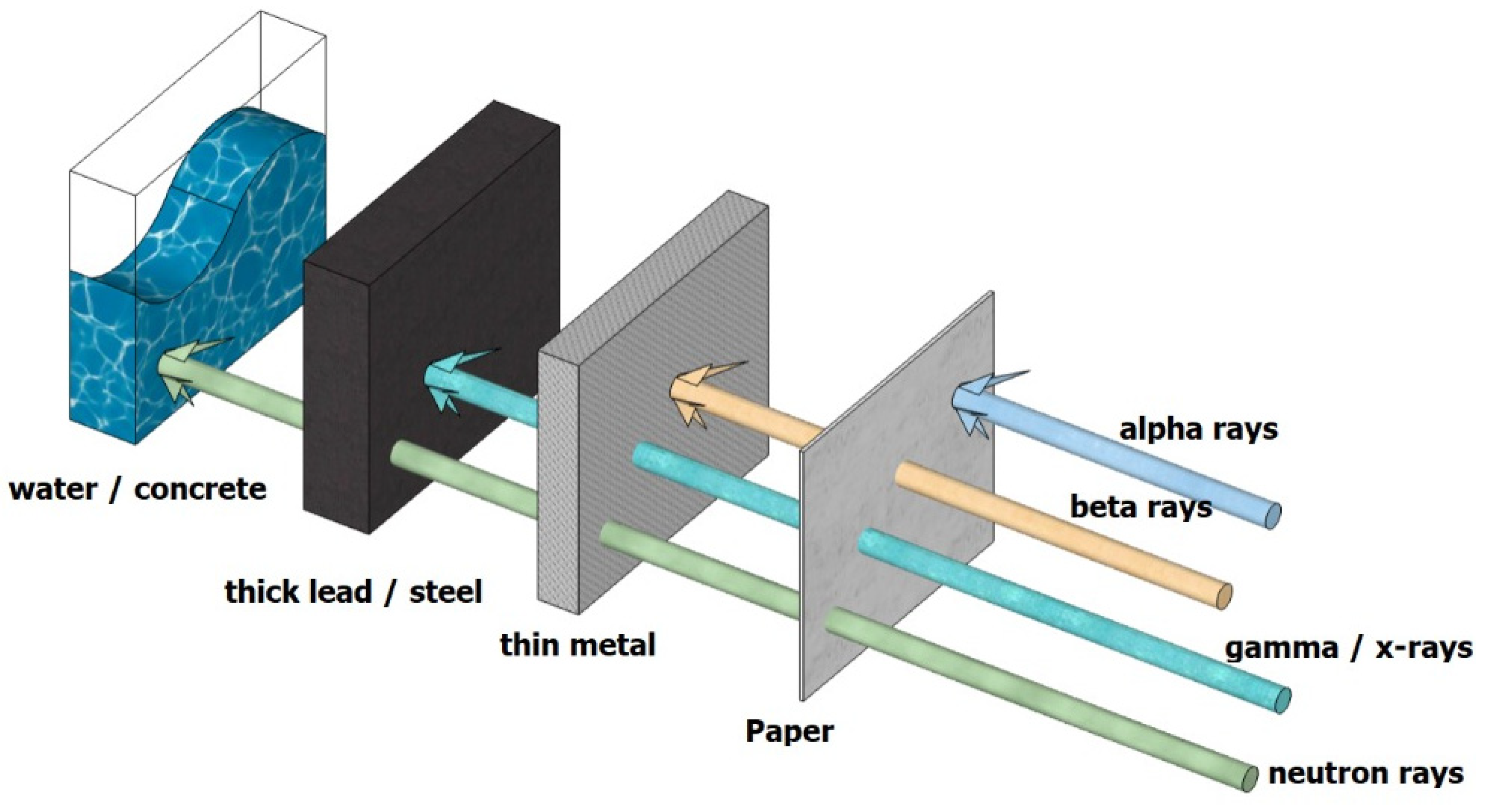
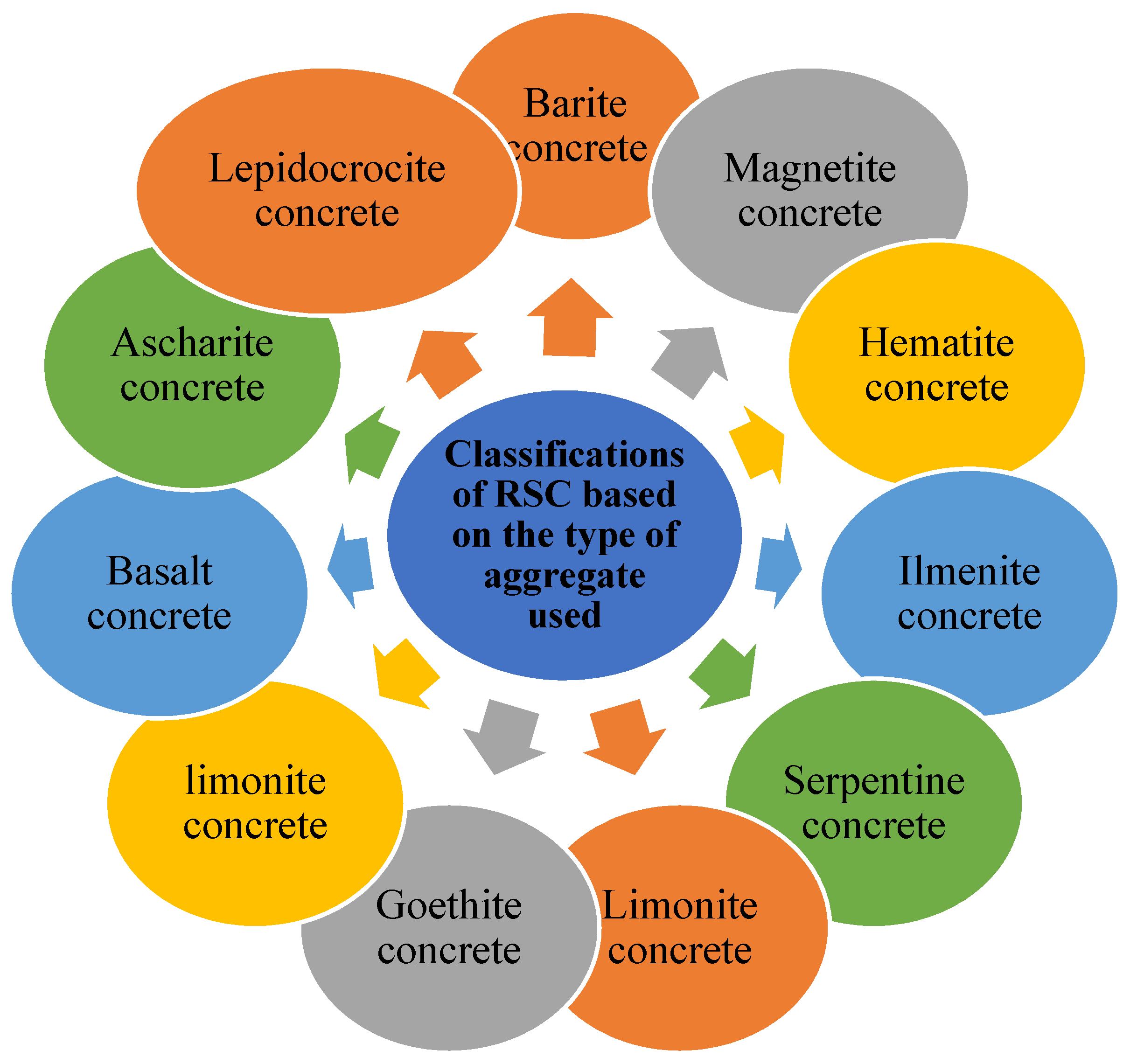


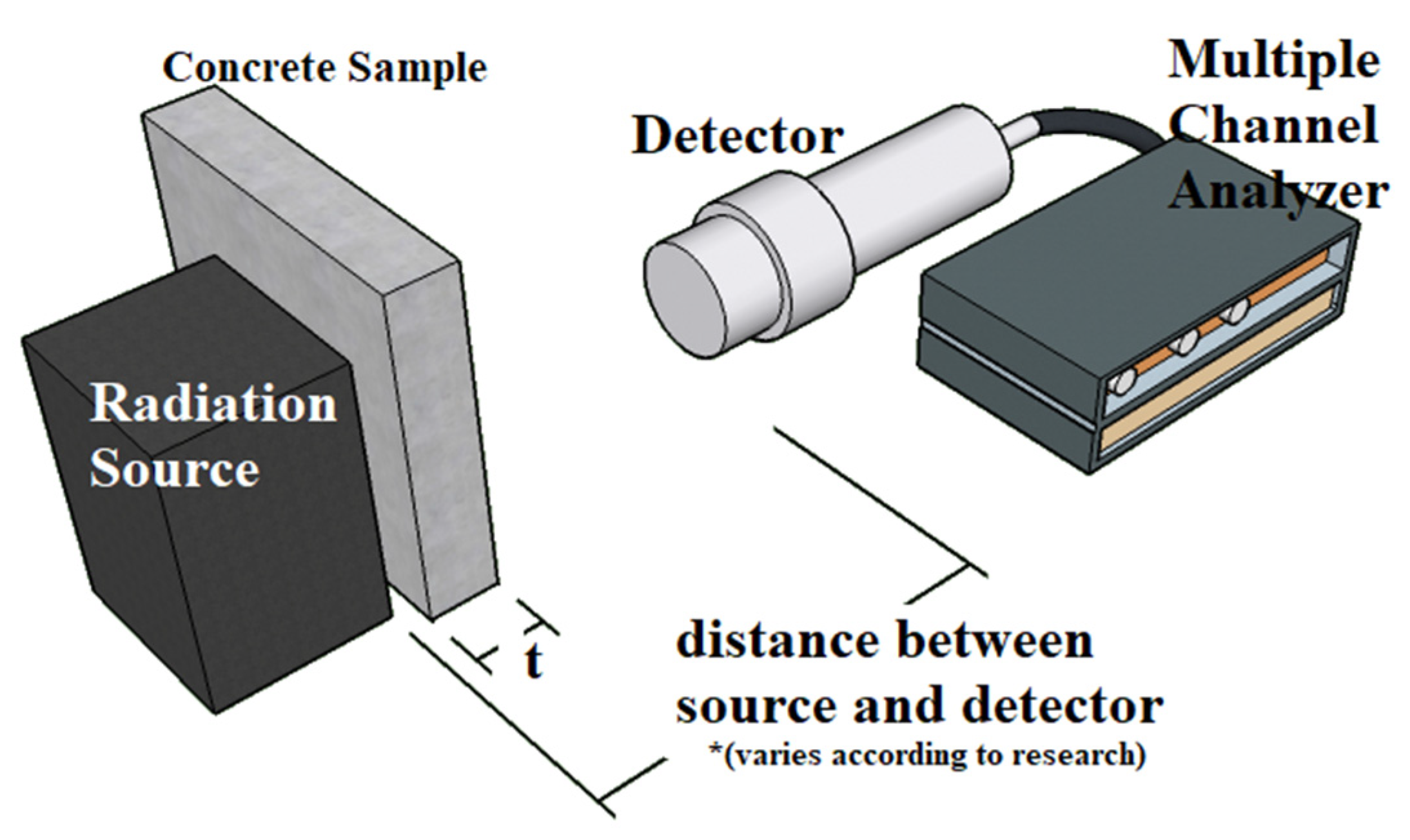
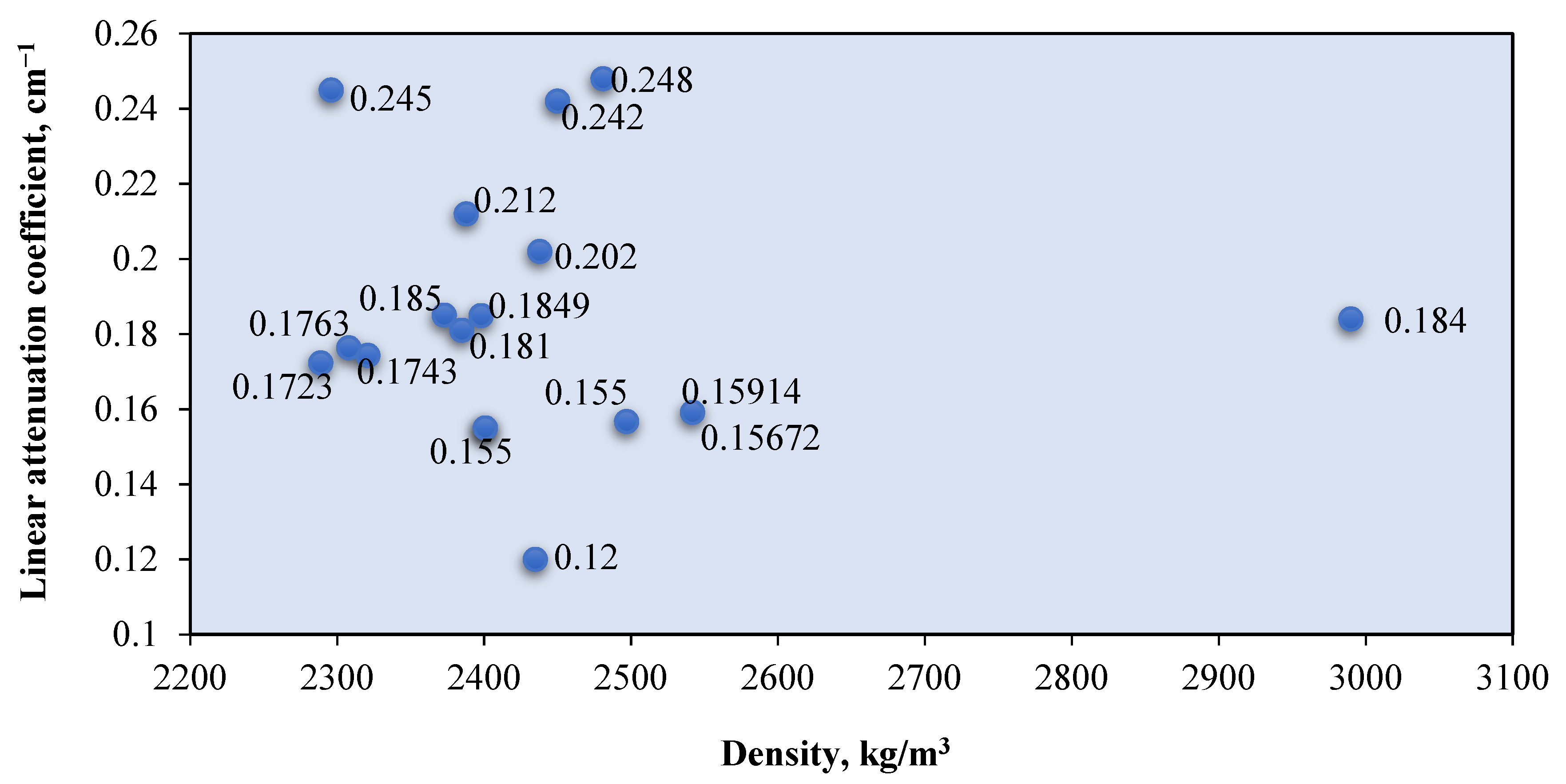
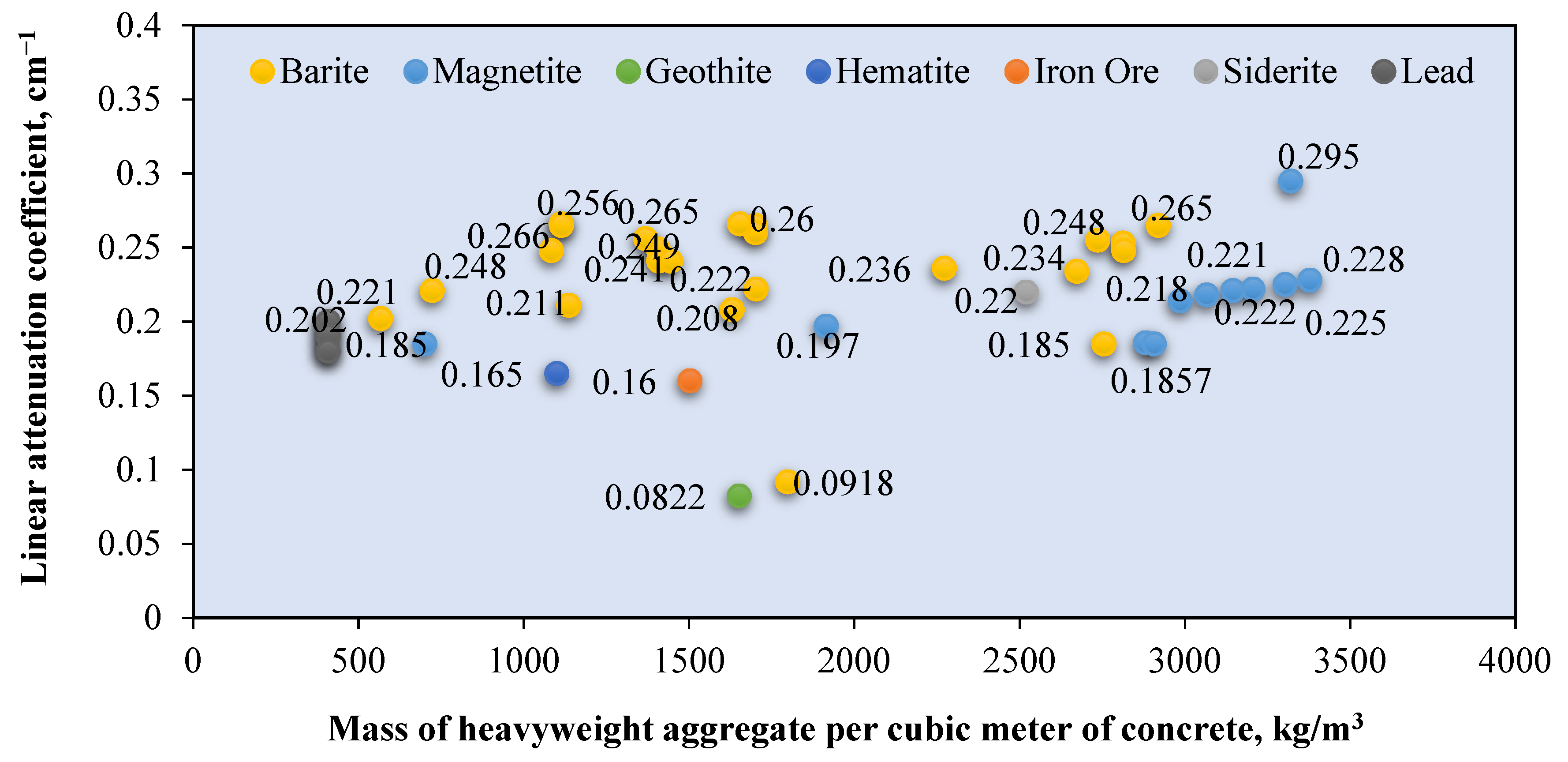
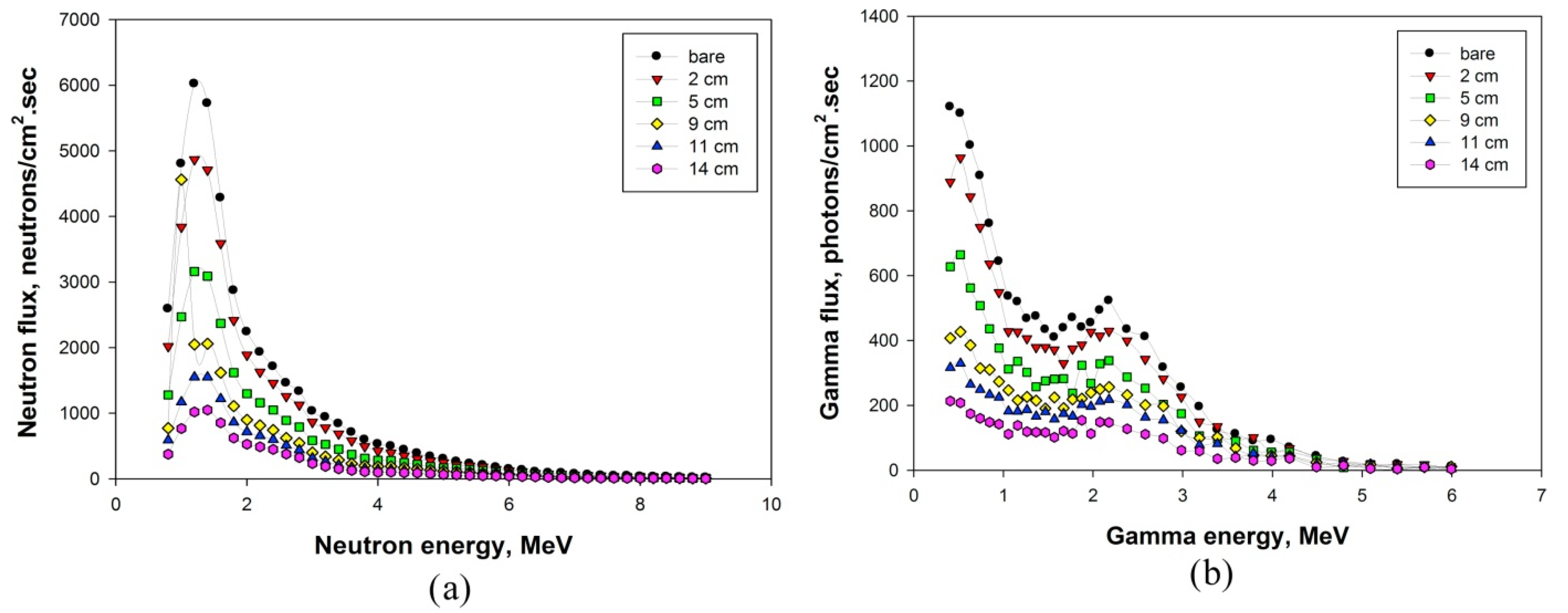
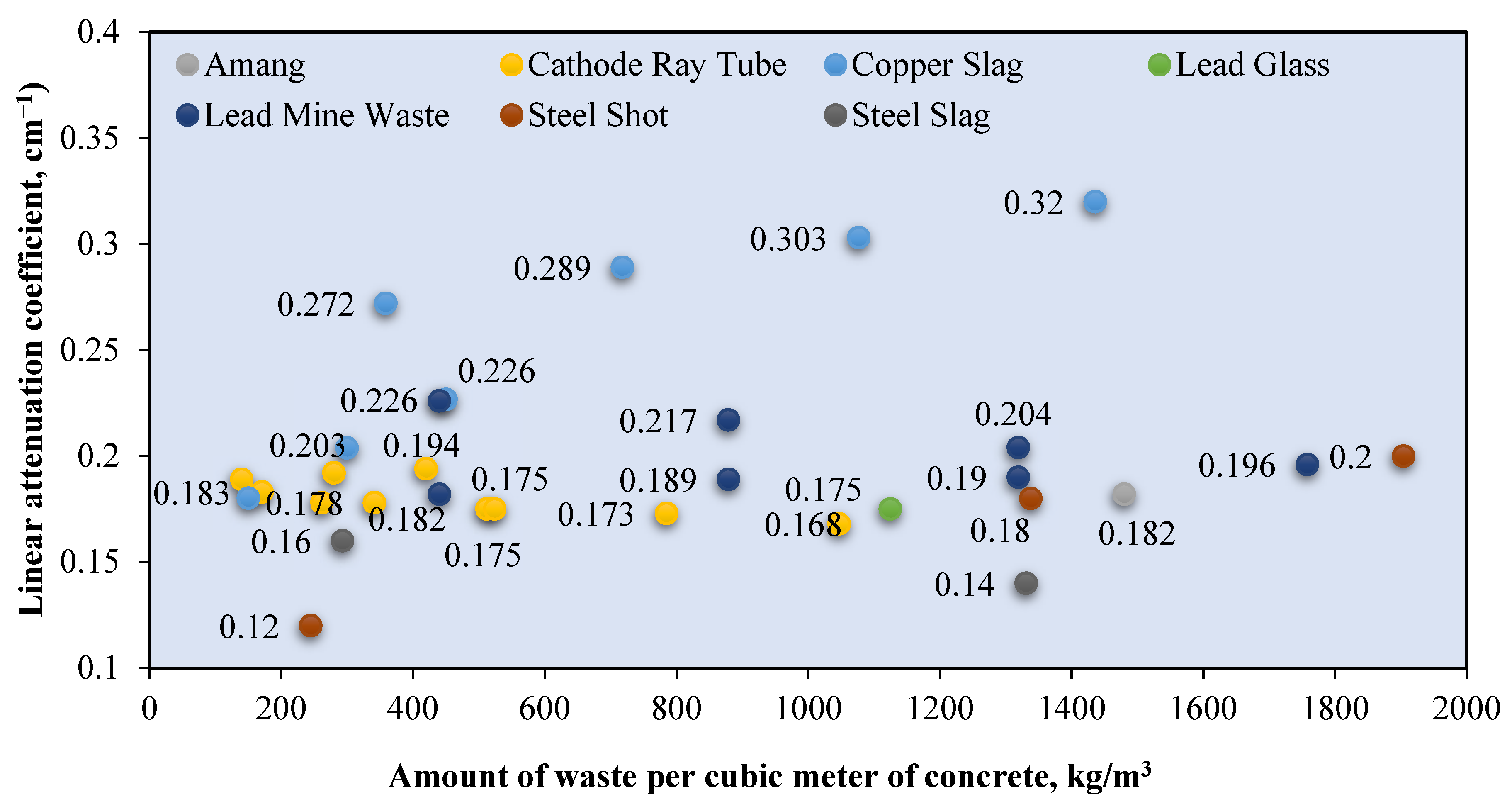


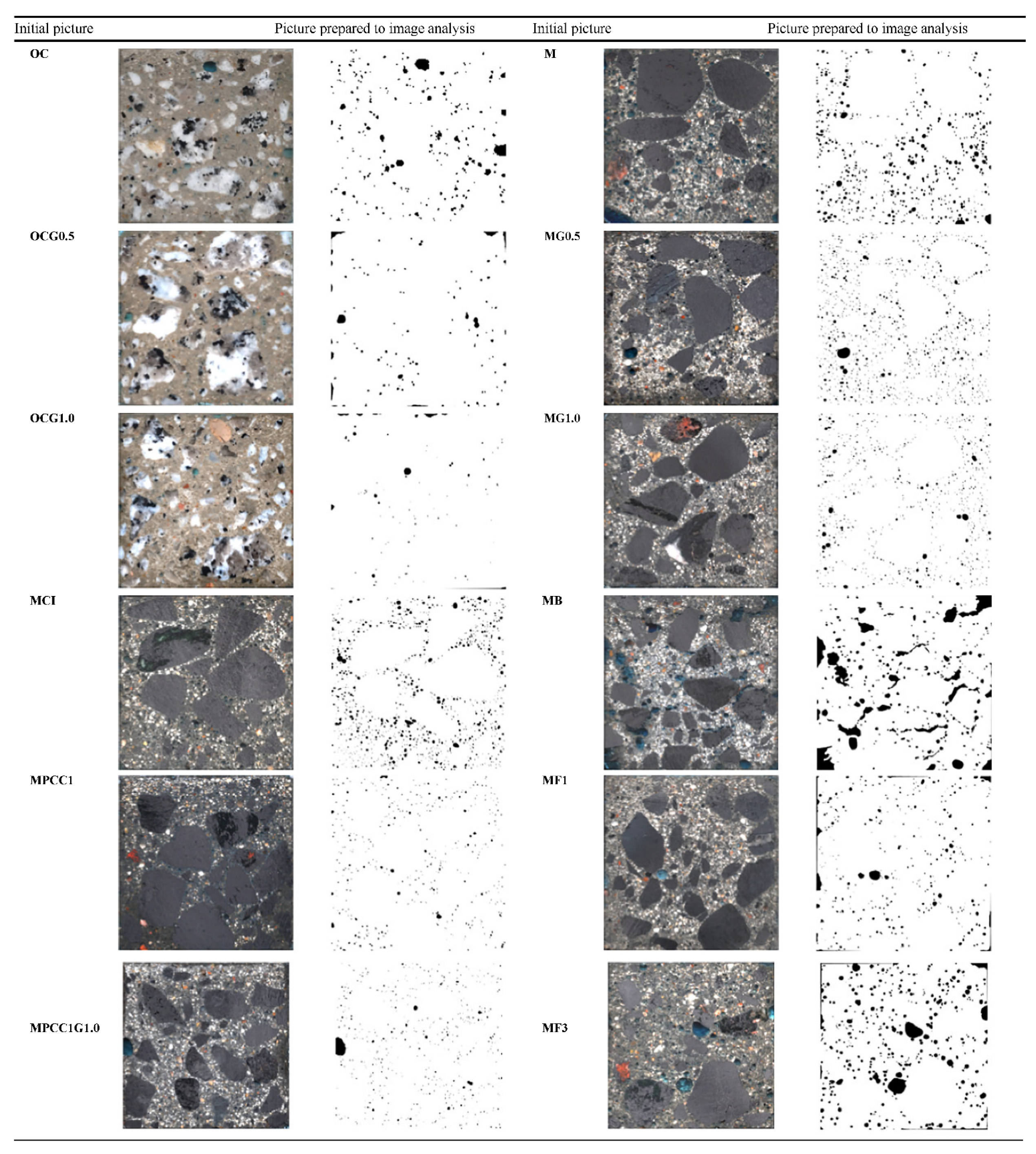

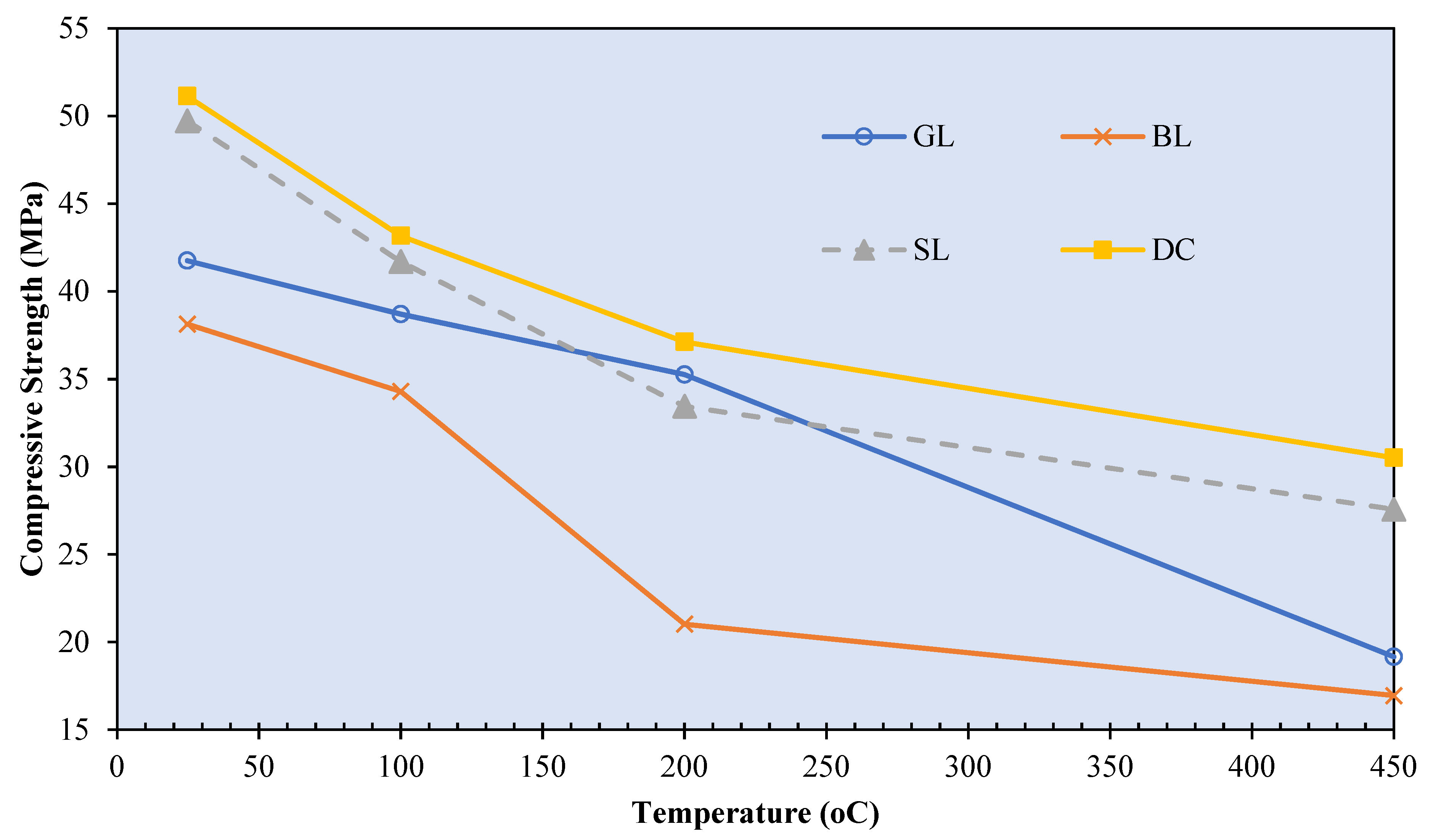

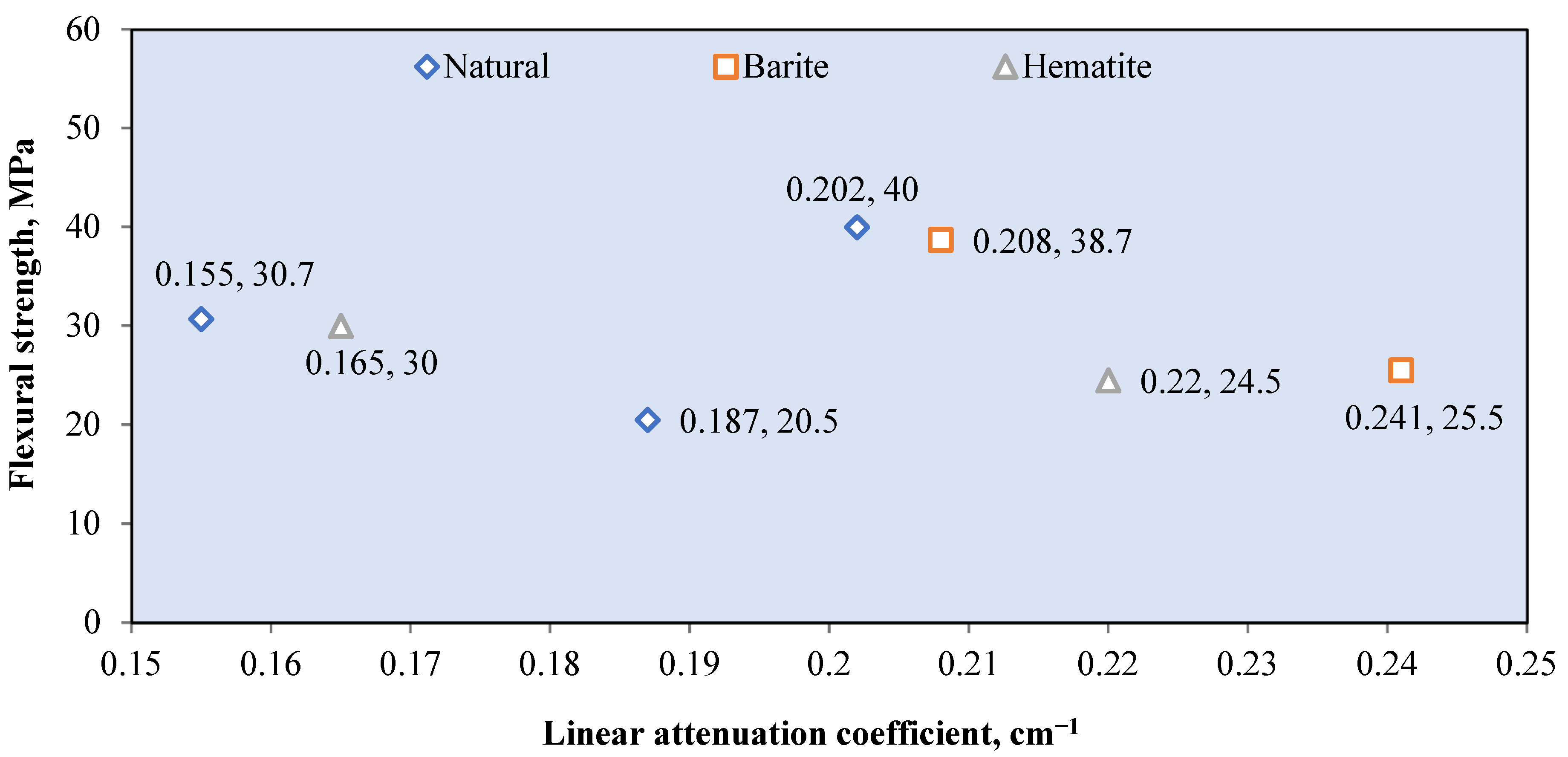

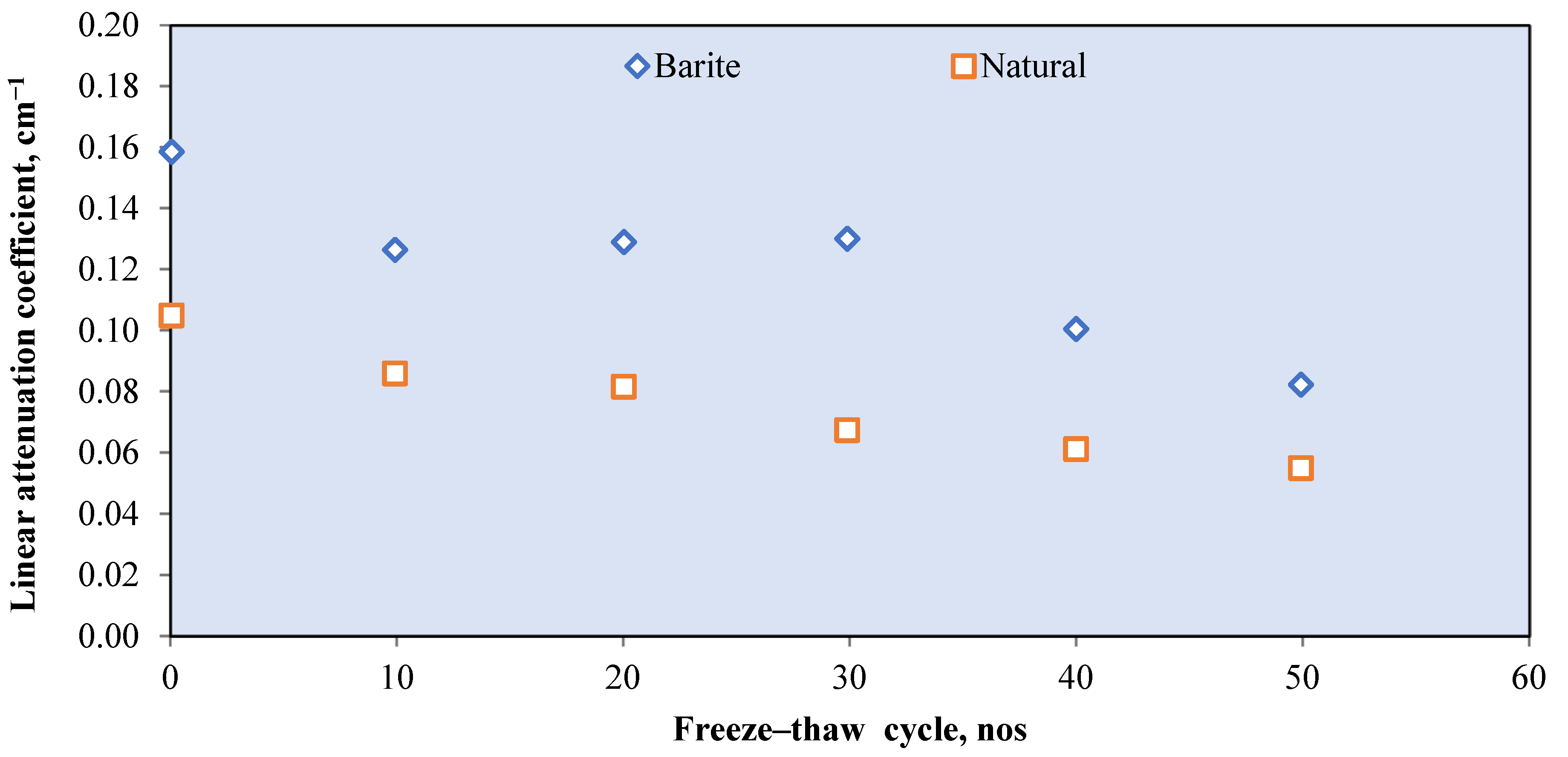

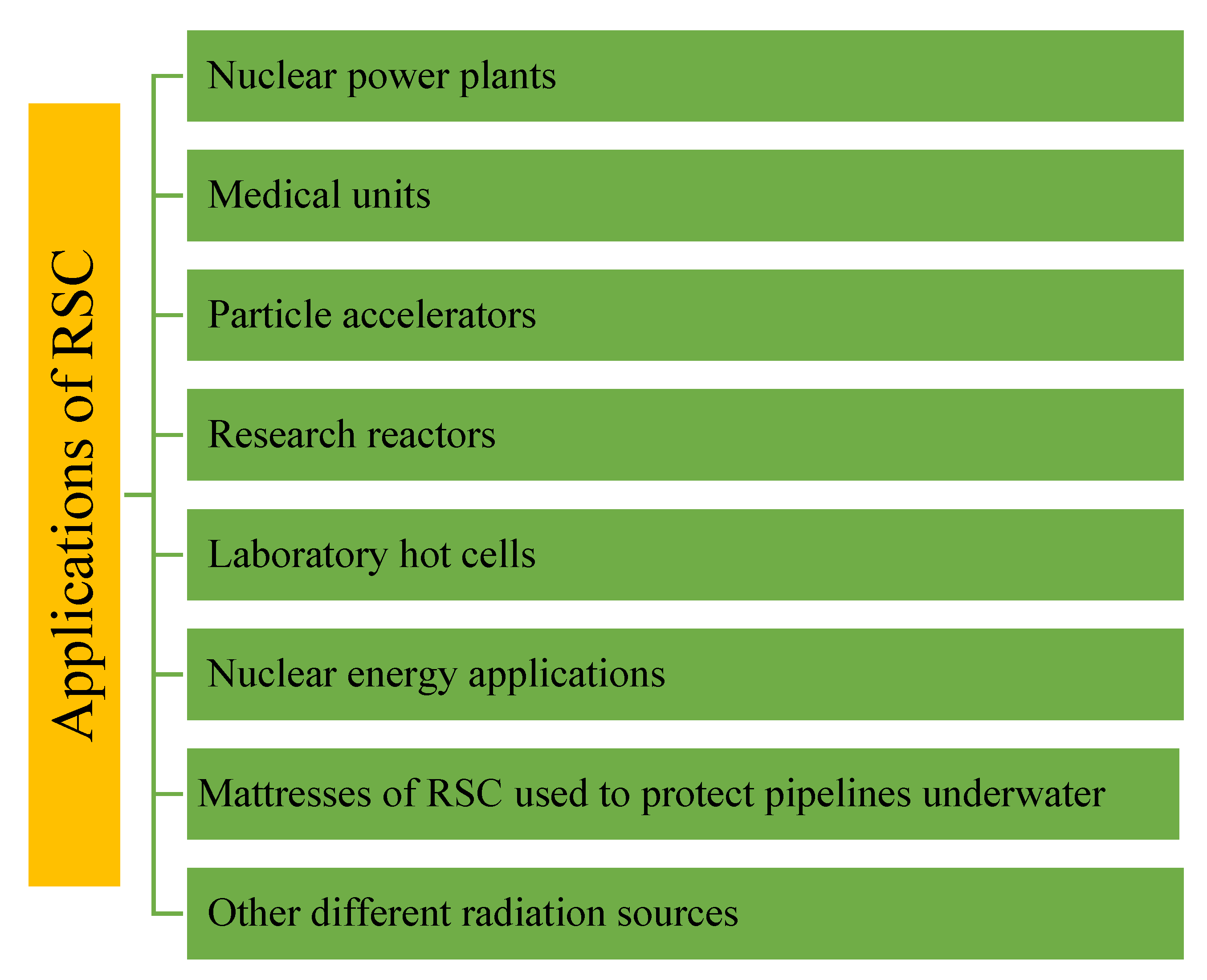
| Types of Aggregates | Relative Density | Chemical Composition of Principal Mineral | Performance | Refs. |
|---|---|---|---|---|
| Magnetite | 4.6–5.2 | Fe3O4 | Shield gamma rays | [68] |
| Barite | 4.0–4.4 | BaSO4 | ||
| Hematite | 4.6–5.2 | Fe2O3 | [69] | |
| Serpentine | 2.4–2.65 | Mg3Si2O5(OH)4 | ||
| Ilmenite | 4.2–4.8 | FeTiO3 | Shield neurons | [70] |
| Ascharite | 3.4–3.6 | Mg2B2O5·H2O | ||
| Limonite | 3.4–4.0 | Hydrous iron ores containing 8–12% water | [71] | |
| Lepidocrocite | - | |||
| Basalt | 2.6–2.8 | – | Shield X-rays | [11] |
| Radiation Source | Distance from Source to Specimen (mm) | Distance from Detector to Specimen (mm) | Thickness of Sample, mm | Detector Type, mm | Dia. of Collimator Opening, mm | Duration of Count Observation, min | Ref. |
|---|---|---|---|---|---|---|---|
| Cs137, Co60 | 20 | 50 | 150 | 50.8 × 50.8 NaI(Tl) | - | - | [95] |
| Cs137, Co60 | - | - | - | 76.2 × 76.2 NaI (TL) | 18 | - | [111] |
| Cs137, Co60 | - | - | 20–100 | 101.2 dia. NaI(Tl) | 15 min | [80] | |
| Cs137 | 330 | 310 | 11–16 | - | 2.8 | - | [112] |
| Cs137 | 500 | 500 | - | Berthold LB-6411 | - | - | [103,113,114] |
| Cs137, Co60 | 147 | 286 | 50.8 × 50.8 NaI(Tl) | 26 | 1.5 min | [62] | |
| Cs137, Co60 | - | - | 20–100 | 76.2 × 76.2 NaI(Tl) | [38] | ||
| Cs137 | 100 | 100 | 10–90 | 50.8 × 50.8 NaI(Tl) | 5 | [115] | |
| Co60 | 100 | 50 | 12–36 | HPGe detector | [23] | ||
| Co60 | 790 | 60 | 26–182 mm | [91] | |||
| Ba133, Am241, Co60 | 100 | 50 | NaI(Tl) | Pin hole, (1 cm2) | [108,116,117] | ||
| Cs137, Co60 | 20 | 50 | 10–40 | 76.2 × 76.2 NaI(Tl) | 10 slit | - | [20] |
| Cs137 | - | 350 | 80 | Scintillation type detector | - | 60 min | [53] |
| Co60 | 200 | 200 | 20 | HPGe type detector | - | - | [81] |
| Cs137, Co60, | 50 | 400 | 40–120 | Scintillator 40 × 40 | - | 120 min | [109] |
| Sample Name | Aggregate | Fe2O3 (%) | Fe3SO4 (%) | BaSO4/BaO (%) | Linear Attenuation Coefficient, μ (cm−1) | Aggregate Volume by Weight in Mix (kg/m3) | Ref. |
|---|---|---|---|---|---|---|---|
| B-UHPC | Barite | - | - | 58.69 | 0.208 | 1630 | [18] |
| BL | Barite | - | - | 20.84 | 0.0918 | 1798.3 | [67] |
| B | Barite | - | - | 74.31 | 0.241 | 1444 | [45] |
| BC | Barite | - | - | 90.3 | 0.265 | 2920 | [53] |
| MC | Magnetite | - | 90.8 | - | 0.295 | 3320 | [53] |
| S1 | Magnetite | 72.1 | - | - | 0.228 | 3378.3 | [12] |
| H-UHPC | Hematite | 71.71 | - | - | 0.165 | 1100 | [18] |
| G.L | Geothite | 67.0 | - | - | 0.0822 | 1651.3 | [67] |
| Sample | Source | Energy (MeV) | ∑R (En) (cm−1) | Aggregate | Mass of Aggregate per Cubic Meter of Concrete (kg/m3) | Refs. |
|---|---|---|---|---|---|---|
| CC1 | Am–Be | 4 | 0.075 | Natural | 1762.7 | [13] |
| CC | Am–Be | 4 | 0.104 | Granite | 1363.9 | [160] |
| NC | Am–Be | 0.025 | 0.133 | Natural | 1746 | [123] |
| PC00 | Am–Be | 0.13954 | Limestone | 1812.5 | [81] | |
| BC | Am–Be | 0.025 | 0.15 | Barite | 2673 | [123] |
| B100 | Am–Be | 4.5 | Barite | [161] | ||
| M | Pu–Be | 0.0996 | Magnetite | 2078 | [163] | |
| B85C15 | Am–Be | 4.5 | Barite (85–95%) + colemanite (5–10%) | [161] | ||
| N85C15 | Am–Be | 4.5 | Natural (85–95%) + colemanite (5–15%) | [161] | ||
| FCL | Am–Be | 4.5 | 0.148 | Limonite | 2369.28 | [165] |
| HC50 | Am–Be | 0.14112 | Limestone + hematite | 1254.7 | [81] | |
| Peridotite Concrete | Am–Be | 0.1445 | Peridotite | 1703 | [166] | |
| A | Pu–Be | 4 | 0.0922 | Serpentine | 1556.1 | [110] |
| ABC | Pu–Be | 0.8–11 | 0.0702–0.0922 | Serpentine | 1856.1 | [109] |
| AB 25, AB50 | Pu–Be | 4 | 0.1226–0.1484 | Serpentine +barite (25–50%) | 1538.61 | [110] |
| AH25, AH50 | Pu–Be | 4 | 0.1105–0.1398 | Serpentine + hematite (25–50%) | 1429.05 | [110] |
| SC | Am–Be | 0.025 | 0.1525 | Siderite + barite | 2520 | [123] |
| L1 | Am–Be | 4 | 0.069–0.09 | Natural aggregate + SBR | 1765.2 | [13] |
| MP1-MP9 | Am–Be | 4 | 0.1077–0.1103 | Granite + HDPE | 1274.7 | [160] |
| CFM | reactor ET-RR-1 | 2–15 | 0.196 | SBR + magnetite + boron carbide | [64] | |
| MPCC1G1.0 | Pu–Be | 0.1034 | Magnetite + acrylic + gadolinium | 2078 | [163] |
| RSC with Compressive Strength of Less than 50 MPa | ||||||
|---|---|---|---|---|---|---|
| Sample | Density (kg/m3) | Compressive Strength (MPa) | μ (cm−1) | Aggregate | Ref. | |
| 50B50LS | 3270 | 33.1 | 0.211 | Barite | [88] | |
| 100B | 3610 | 32.9 | 0.236 | Barite | [88] | |
| BC | 3441 | 49 | 0.265 | Barite | [53] | |
| CB-FA-50 | 3230 | 32 | 0.175 | Barite | [65] | |
| CB-0 | 3410 | 35 | 0.185 | Barite | [65] | |
| B.L | 2963 | 38 | 0.092 | Barite | [67] | |
| G.L | 2906 | 41 | 0.082 | Geothite | [67] | |
| IO100 | 3029 | 40 | 0.160 | Iron ore | [120] | |
| BW6 | 3740 | 44.1 | 0.198 | Magnetite + Bi2O3 (3%) + WO3 (3%) | [14] | |
| M-4 | 2620 | 34.1 | 0.194 | Magnetite | [106] | |
| O | 3708 | 40.7 | 0.186 | Magnetite | [14] | |
| 100MW | 3040 | 43.84 | 0.196 | Mine waste | [88] | |
| LSA100 | 2435 | 42 | 0.120 | Natural | [120] | |
| 100LS | 2990 | 37.7 | 0.184 | Natural | [88] | |
| s4 | 3687 | 41 | 0.221 | Natural | [12] | |
| G0C0 | 2296 | 35.7 | 0.245 | Natural | [95] | |
| G60C100 | 2845 | 32.4 | 0.333 | Slag | [95] | |
| 7 | 46.5 | 0.201 | Slag | [128] | ||
| S.L | 2994 | 49 | 0.083 | Slag | [67] | |
| SA100 | 2790 | 45 | 0.140 | Slag | [120] | |
| SS100 | 3563 | 30 | 0.200 | Steel shot | [120] | |
| RSC with compressive strength of greater than 50 MPa | ||||||
| Sample | Density (kg/m3) | w/c | Compressive strength (Mpa) | μ (0.662 Mev) | Aggregate | Ref. |
| BC | 3311.85 | 0.4 | 58.1 | 0.234 | Barite | [123] |
| B-UHPC | 3112 | 0.16 | 138 | 0.208 | Barite | [18] |
| B | 2943 | 0.18 | 172 | 0.241 | Barite | [45] |
| Q+B | 2684 | 0.18 | 190 | 0.221 | Barite | [45] |
| D.C | 2570 | 0.43 | 51.0 | 0.0797 | Dolomite | [67] |
| H-UHPC | 2602 | 0.19 | 149 | 0.165 | Hematite | [18] |
| HP-50 | 2900 | 0.17 | 170 | 0.022 | Hematite + Silica | [46] |
| SC | 3158.85 | 0.4 | 63.8 | 0.22 | Siderite | [123] |
| M-U | 0.16 | 134 | 0.197 | Magnetite | [44] | |
| MC | 3939 | 0.35 | 56.0 | 0.295 | Magnetite | [53] |
| 70NCA | 2398 | 0.23 | 87.0 | 0.1849 | Natural | [66] |
| s1 | 3871 | 0.4 | 62.0 | 0.228 | Natural | [12] |
| M-0.35/CS0 | 2542 | 0.35 | 67.4 | 0.15914 | Natural | [122] |
| SS-UHPC | 2401 | 0.16 | 165.7 | 0.155 | Natural | [24] |
| Q | 2438 | 0.18 | 218 | 0.202 | Natural | [45] |
| SS-UHPC | 2401 | 0.16 | 166 | 0.155 | Natural | [18] |
| HP-0 | 2500 | 0.14 | 160 | 0.0187 | Natural | [46] |
| 70RCA | 2321 | 0.23 | 80 | 0.1743 | Recycled aggregate | [66] |
| 40RCA | 2289 | 0.37 | 50 | 0.1723 | Recycled aggregate | [66] |
| M-0.35/CS60/SF | 2668 | 0.35 | 78.62 | 0.23771 | Slag | [122] |
| LG-UHPC | 2479 | 0.17 | 170.1 | 0.175 | Lead glass | [24] |
| A-UHPC | 3036 | 0.16 | 157.5 | 0.182 | Mine waste | [24] |
| Name | Steel Fiber (%) | LAC (cm−1) | Aggregate | Tensile Strength (MPa) | Ref. |
|---|---|---|---|---|---|
| S1 | 0 | 0.228 | Natural | 4.82 | [12] |
| M-0.35/CS0 | 0 | 0.159 | Natural | 3.79 | [122] |
| CB-0 | 0 | 0.185 | Barite | 3.6 | [65] |
| CB-CA-10 | 0 | 0.183 | Barite + CRT 10% | 3.375 | [65] |
| D12.5W0.45C400 | 0 | 0.211 | Magnetite | 5.06 | [127] |
| G30C0 | 0 | 0.254 | Natural + GGBS | 4.93 | [95] |
| G0C100 | 0 | 0.32 | Copper slag | 4.18 | [95] |
| G30C100 | 0 | 0.328 | Copper slag + GGBS | 3.9 | [95] |
| M-0.35/CS60/SF | 1 | 0.2377 | Natural + copper slag (60%) | 5.79 | [122] |
| M-0.40/CS60/SF | 1 | 0.2296 | Natural + copper slag (60%) | 5.46 | [122] |
| A-UHPC | 1.5 | 0.182 | Amang | 7 | [24] |
| LG-UHPC | 1.5 | 0.175 | Lead glass | 6.9 | [24] |
| H-UHPC | 1.5 | 0.165 | Hematite | 6.28 | [18] |
| B-UHPC | 1.5 | 0.208 | Barite | 6.12 | [18] |
| SS-UHPC | 1.5 | 0.155 | Silica sand | 8 | [24] |
| Name | Steel Fiber (%) | LAC (cm−1) | Aggregate | Flexural Strength (MPa) | Ref. |
|---|---|---|---|---|---|
| M-0.35/CS60/SF | 1 | 0.2377 | Natural + copper slag (60%) | 8.27 | [122] |
| M-0.40/CS60/SF | 1 | 0.2296 | Natural + copper slag (60%) | 7.65 | [122] |
| A-UHPC | 1.5 | 0.182 | Amang | 28.8 | [24] |
| LG-UHPC | 1.5 | 0.175 | Lead glass | 28.3 | [24] |
| H-UHPC | 1.5 | 0.165 | Hematite | 30 | [18] |
| B-UHPC | 1.5 | 0.208 | Barite | 38.7 | [18] |
| SS-UHPC | 1.5 | 0.155 | Silica sand | 30.7 | [24] |
| Q | 2 | 0.202 | Quartz | 40 | [45] |
| B | 2 | 0.241 | Barite | 25.5 | [45] |
| HP-0 | 1.9 | 0.187 | Dune sand | 20.5 | [46] |
| HP-50 | 1.9 | 0.22 | Natural + Hematite (50%) | 24.5 | [46] |
Publisher’s Note: MDPI stays neutral with regard to jurisdictional claims in published maps and institutional affiliations. |
© 2022 by the authors. Licensee MDPI, Basel, Switzerland. This article is an open access article distributed under the terms and conditions of the Creative Commons Attribution (CC BY) license (https://creativecommons.org/licenses/by/4.0/).
Share and Cite
Abdullah, M.A.H.; Rashid, R.S.M.; Amran, M.; Hejazii, F.; Azreen, N.M.; Fediuk, R.; Voo, Y.L.; Vatin, N.I.; Idris, M.I. Recent Trends in Advanced Radiation Shielding Concrete for Construction of Facilities: Materials and Properties. Polymers 2022, 14, 2830. https://doi.org/10.3390/polym14142830
Abdullah MAH, Rashid RSM, Amran M, Hejazii F, Azreen NM, Fediuk R, Voo YL, Vatin NI, Idris MI. Recent Trends in Advanced Radiation Shielding Concrete for Construction of Facilities: Materials and Properties. Polymers. 2022; 14(14):2830. https://doi.org/10.3390/polym14142830
Chicago/Turabian StyleAbdullah, Muhd Afiq Hizami, Raizal Saifulnaz Muhammad Rashid, Mugahed Amran, Farzad Hejazii, N. M. Azreen, Roman Fediuk, Yen Lei Voo, Nikolai Ivanovich Vatin, and Mohd Idzat Idris. 2022. "Recent Trends in Advanced Radiation Shielding Concrete for Construction of Facilities: Materials and Properties" Polymers 14, no. 14: 2830. https://doi.org/10.3390/polym14142830
APA StyleAbdullah, M. A. H., Rashid, R. S. M., Amran, M., Hejazii, F., Azreen, N. M., Fediuk, R., Voo, Y. L., Vatin, N. I., & Idris, M. I. (2022). Recent Trends in Advanced Radiation Shielding Concrete for Construction of Facilities: Materials and Properties. Polymers, 14(14), 2830. https://doi.org/10.3390/polym14142830









